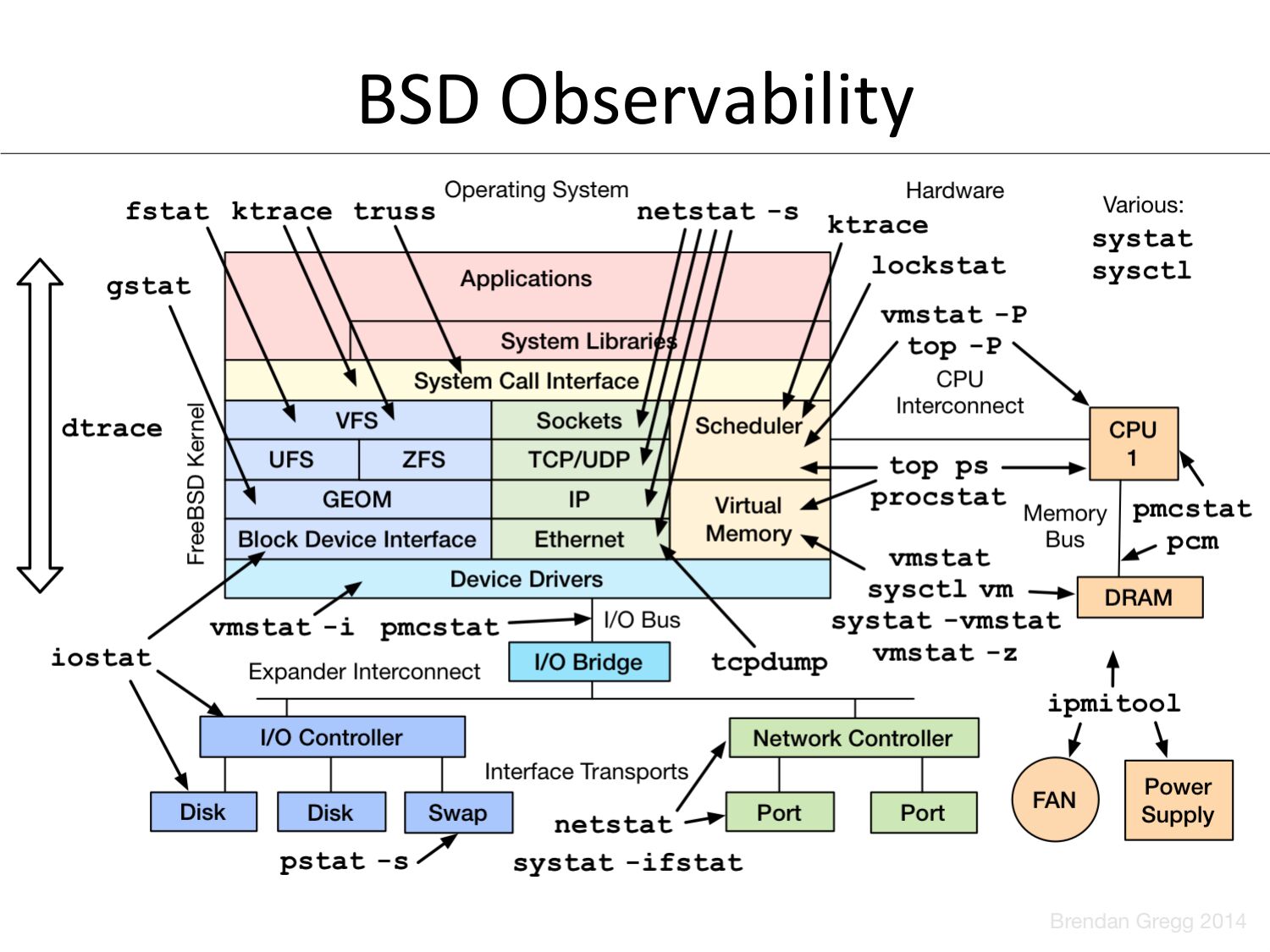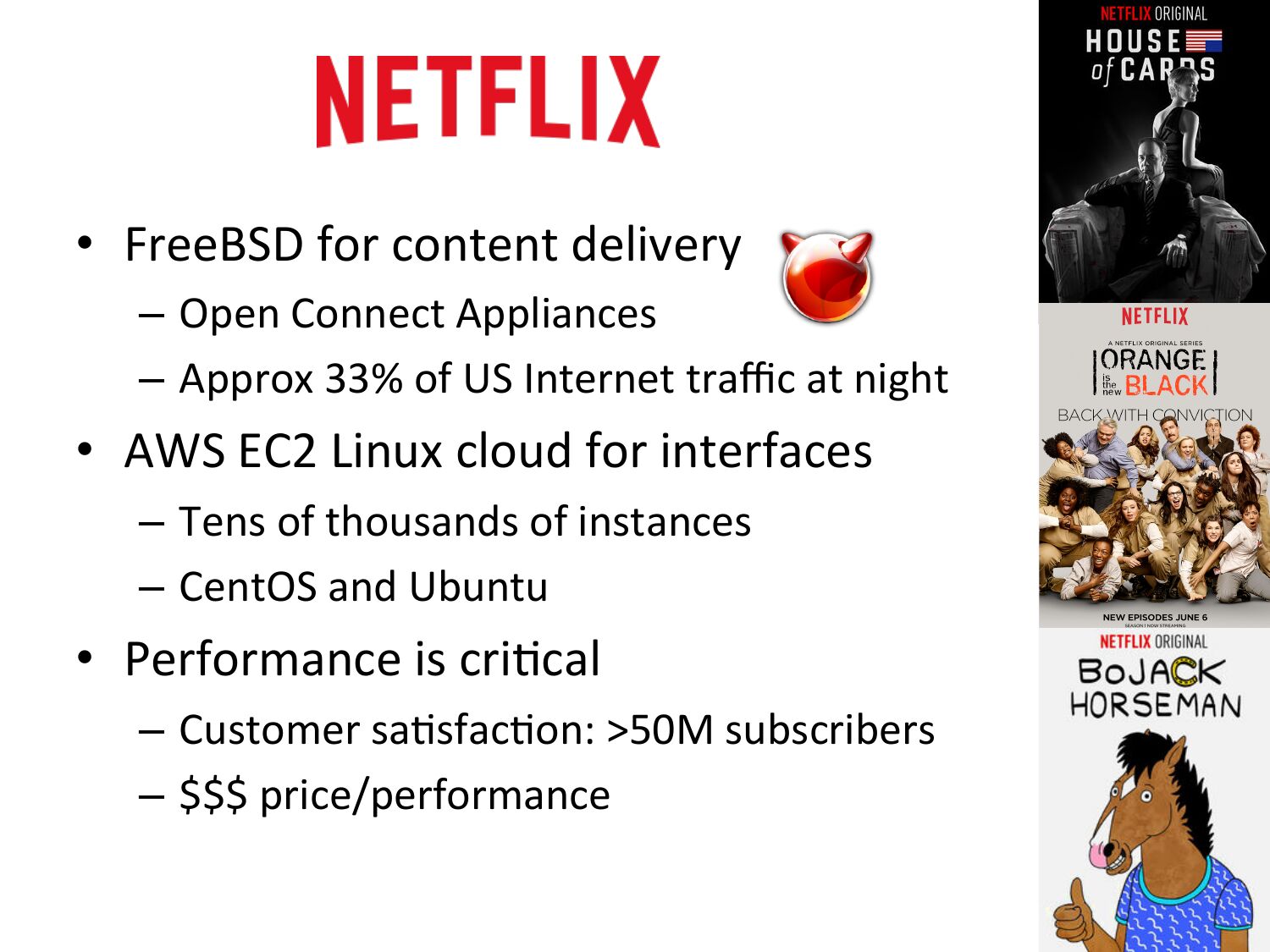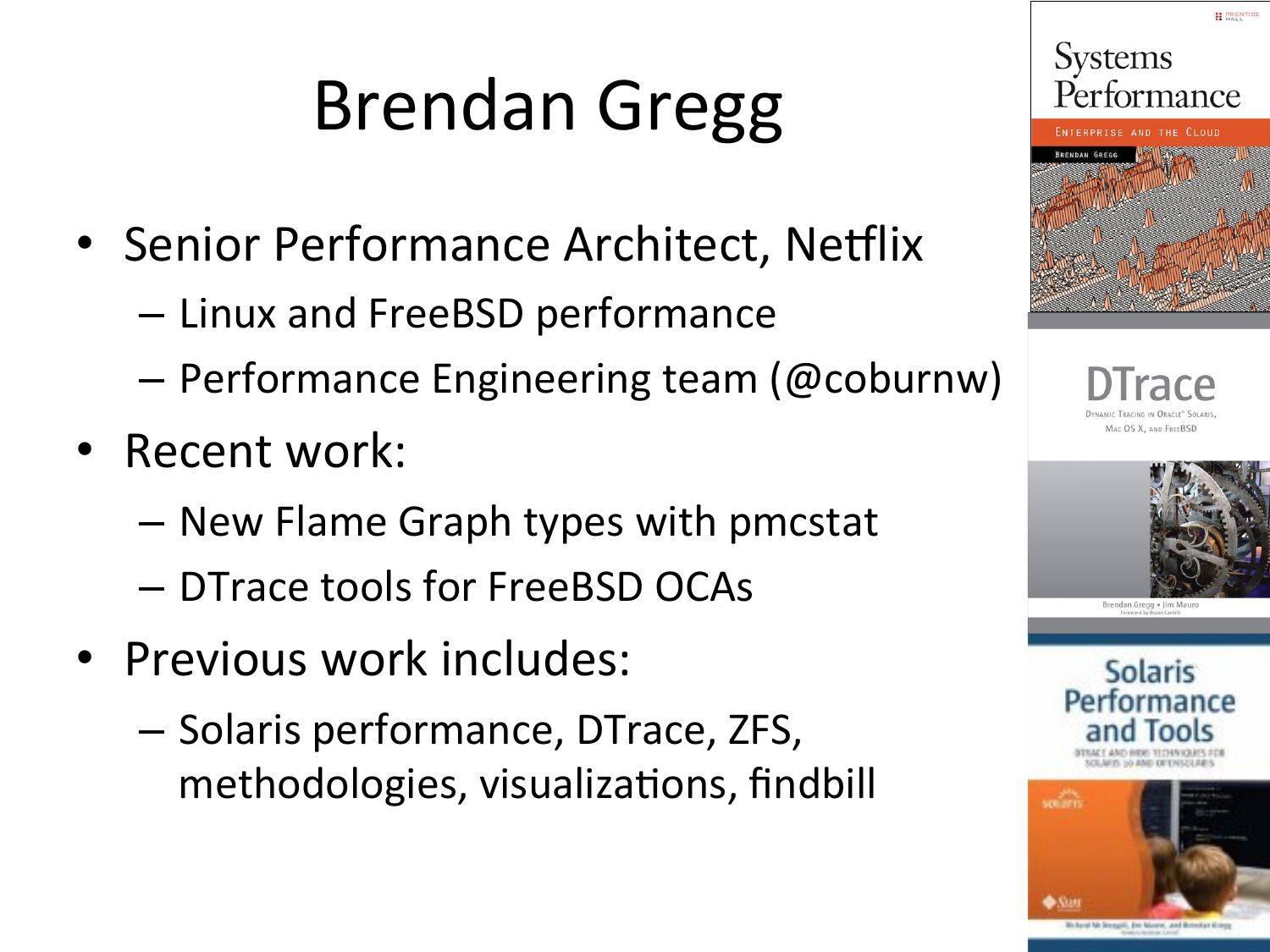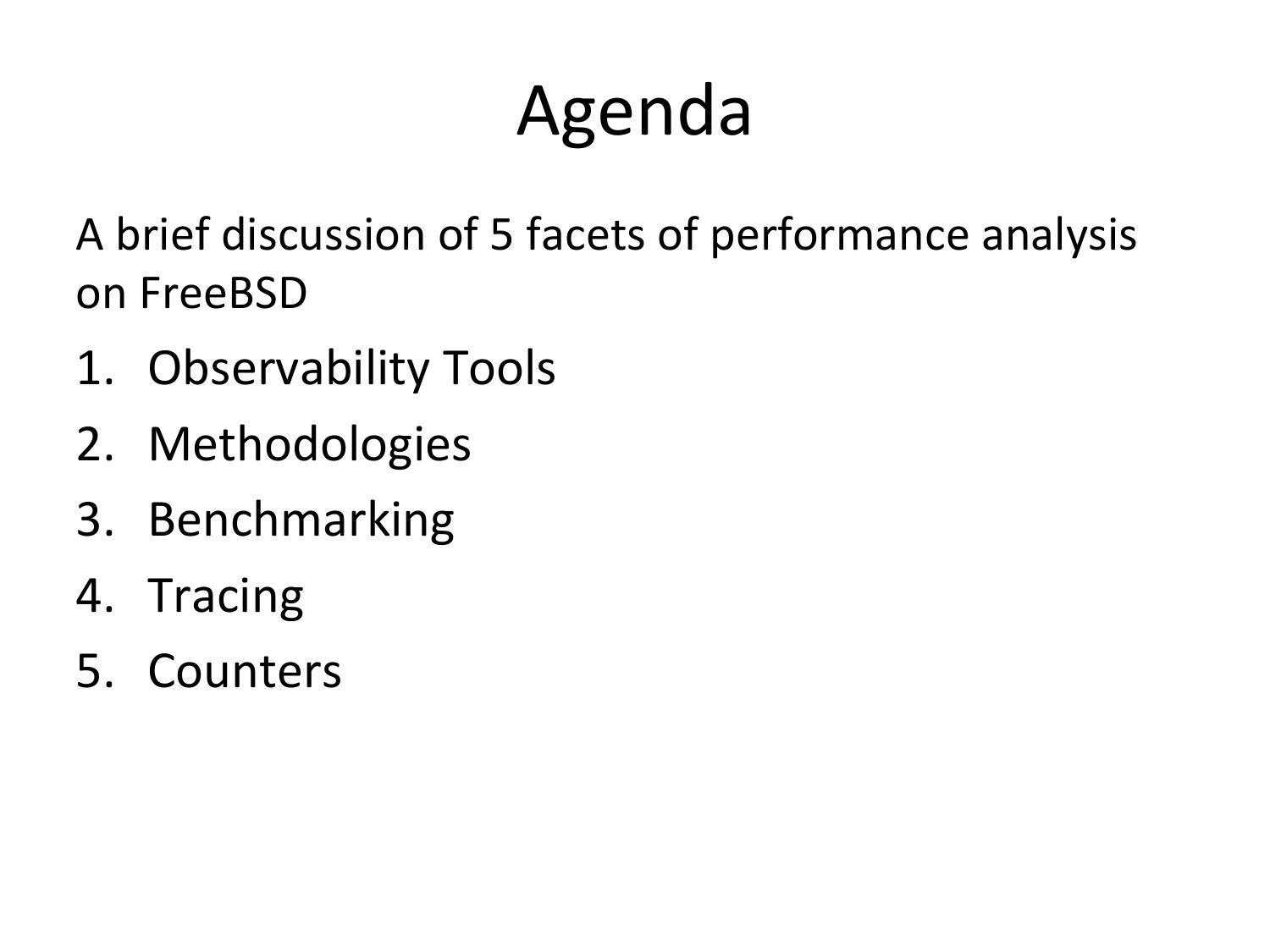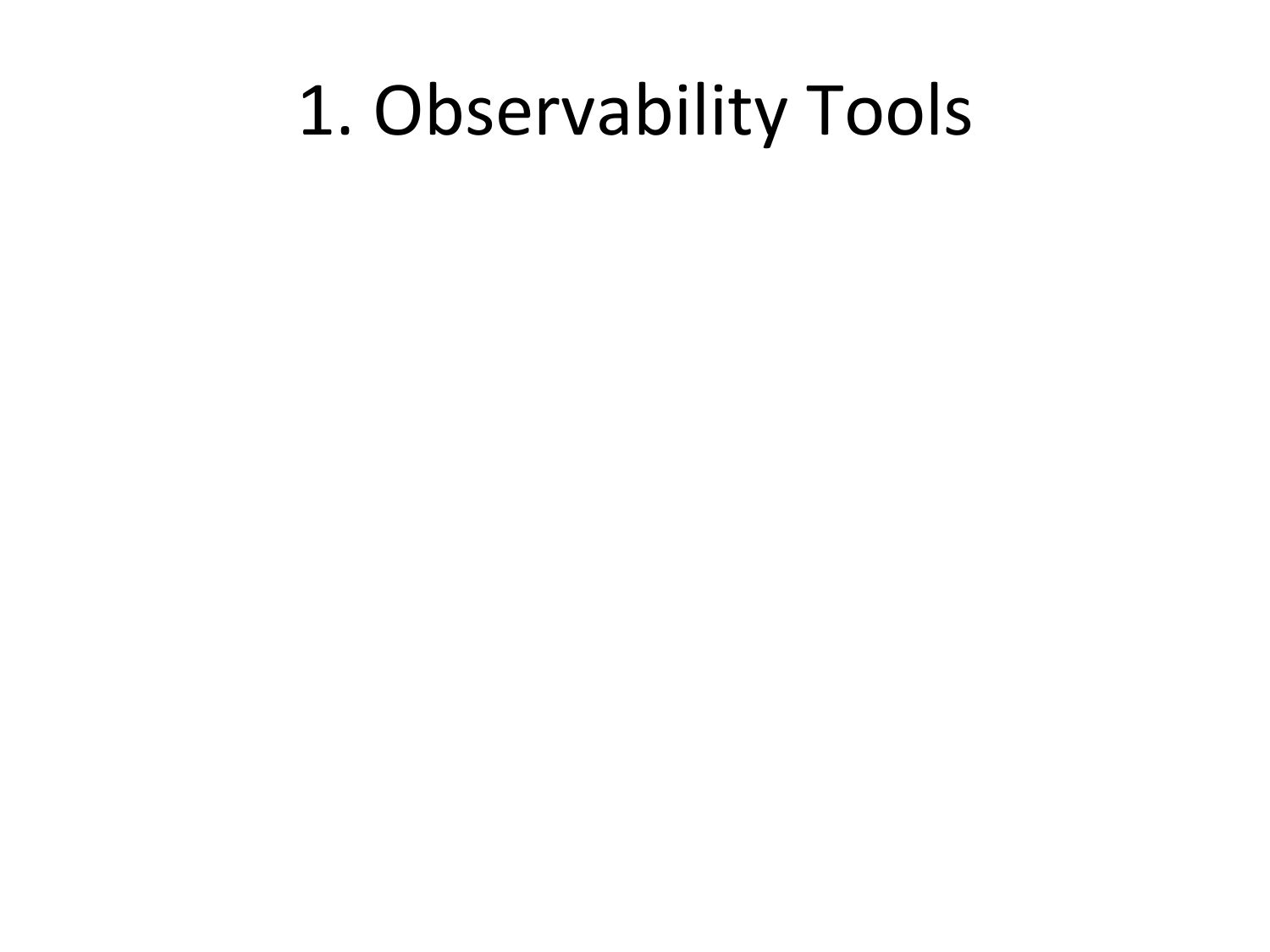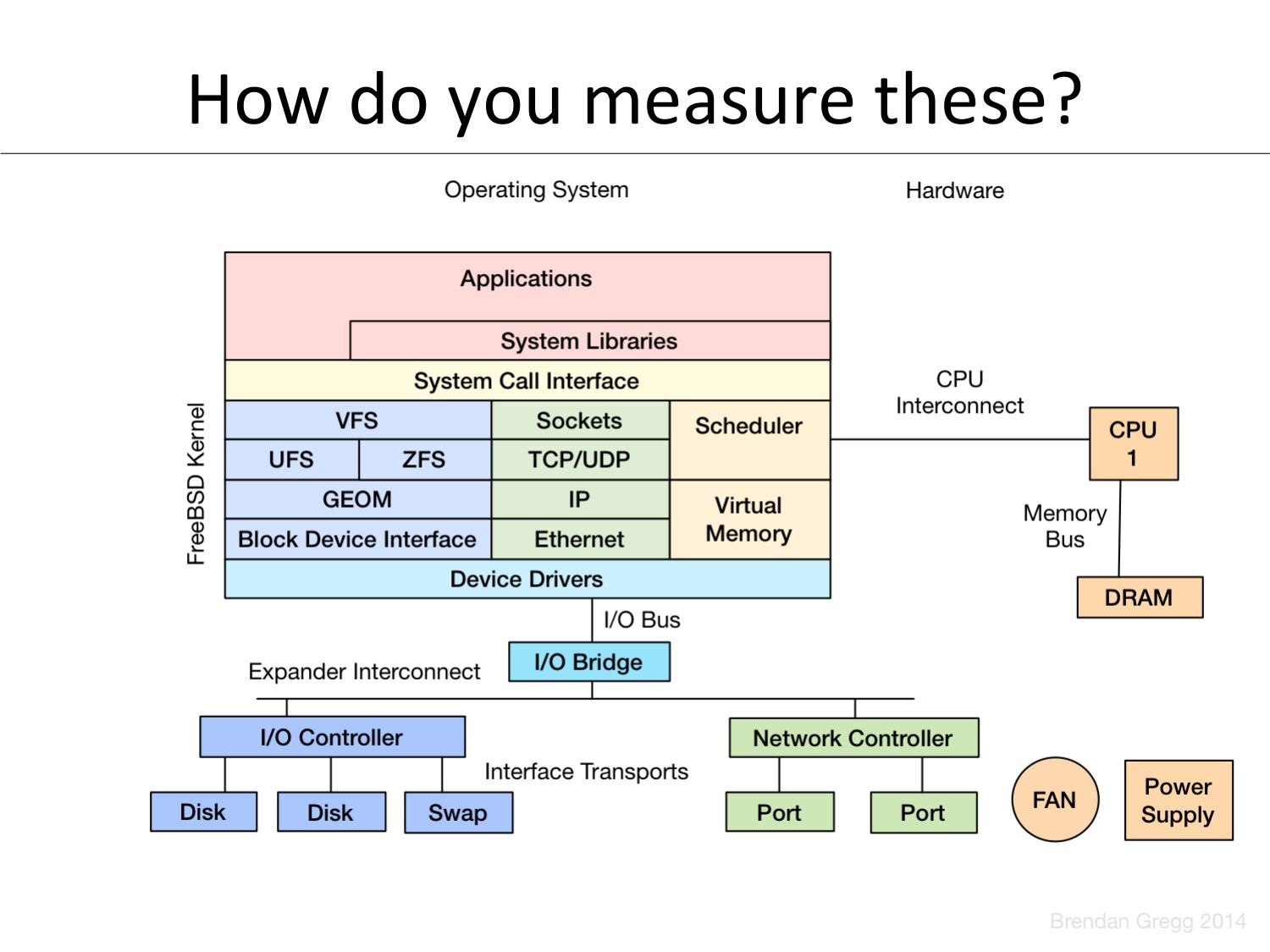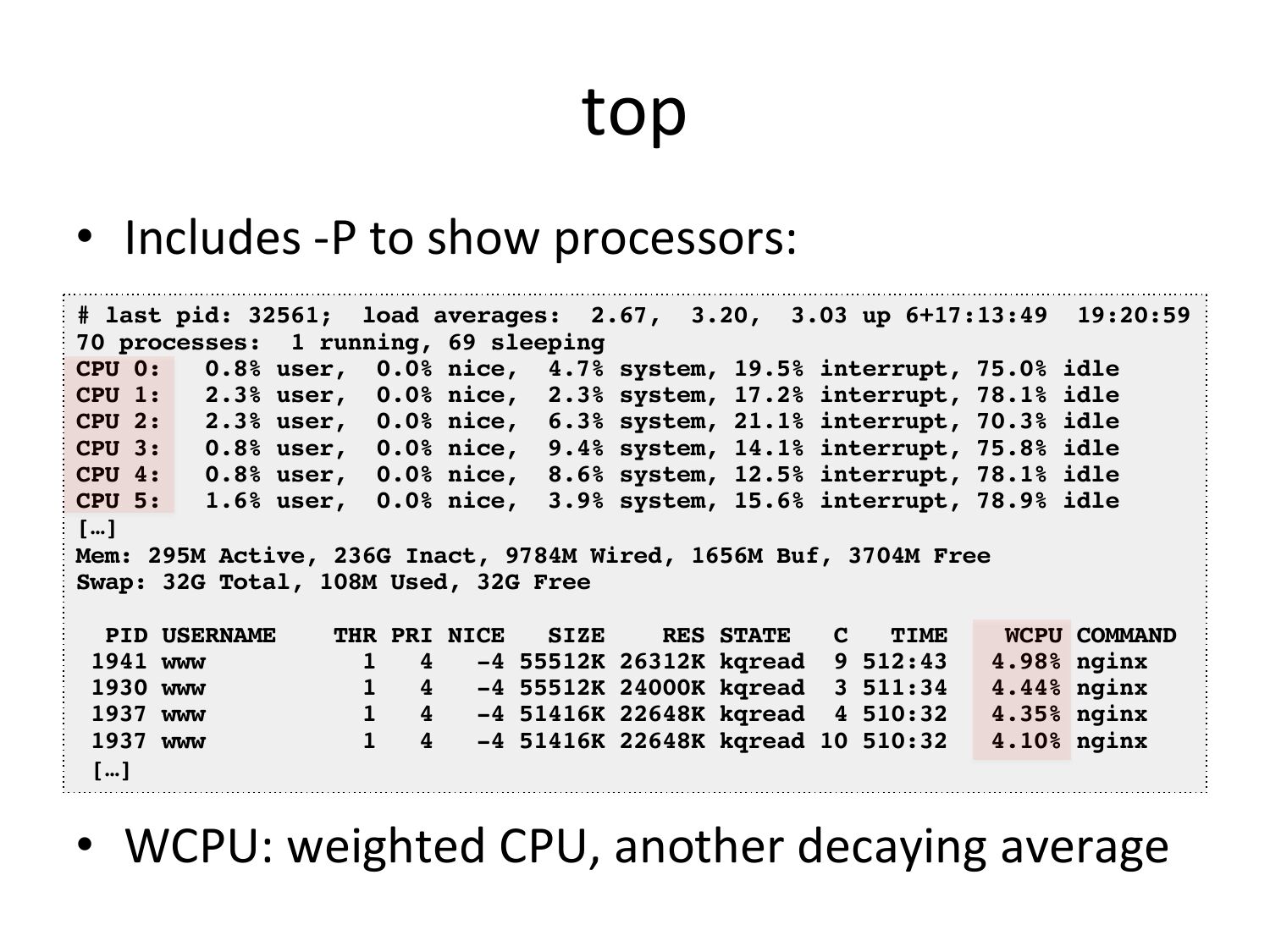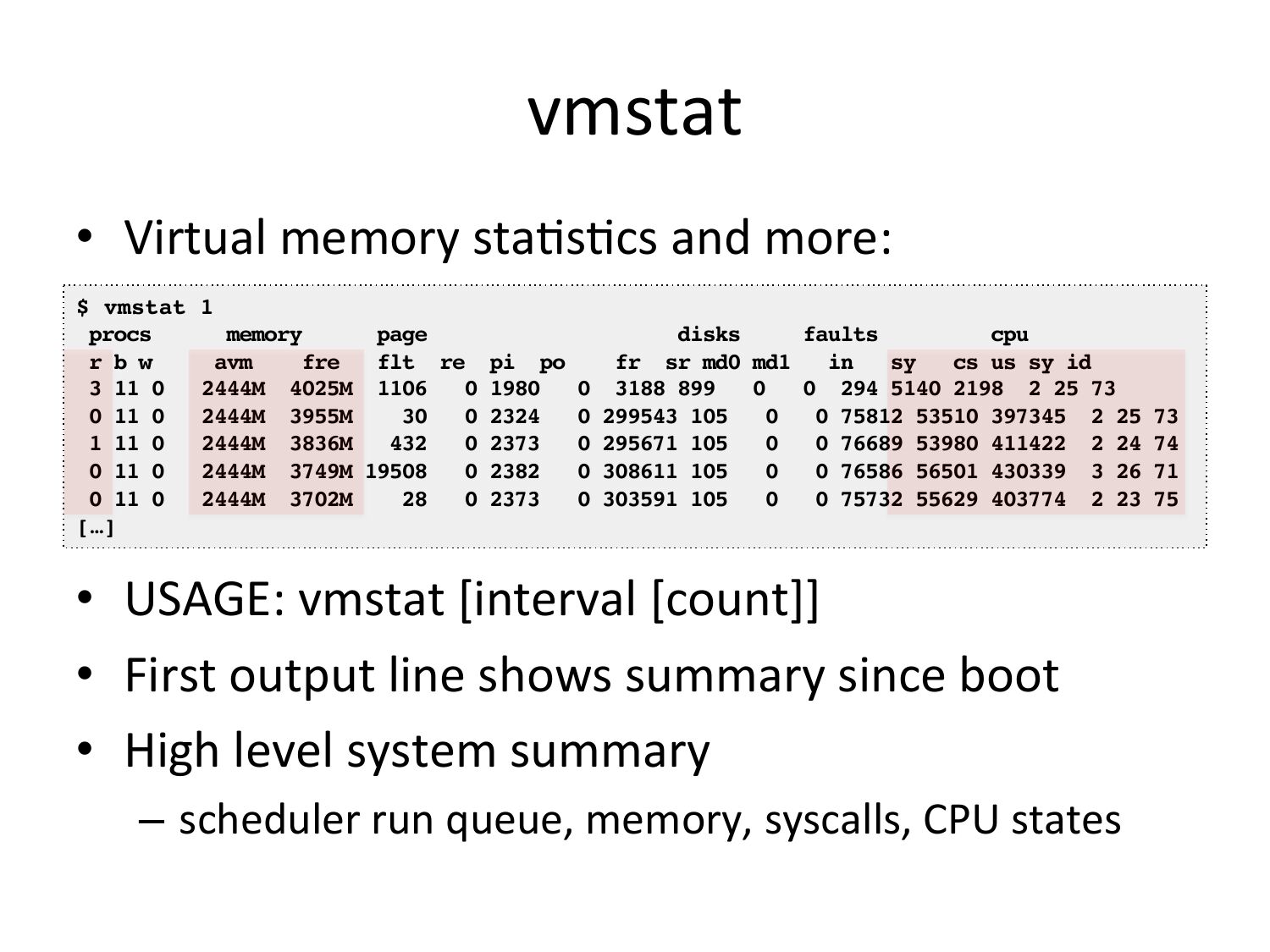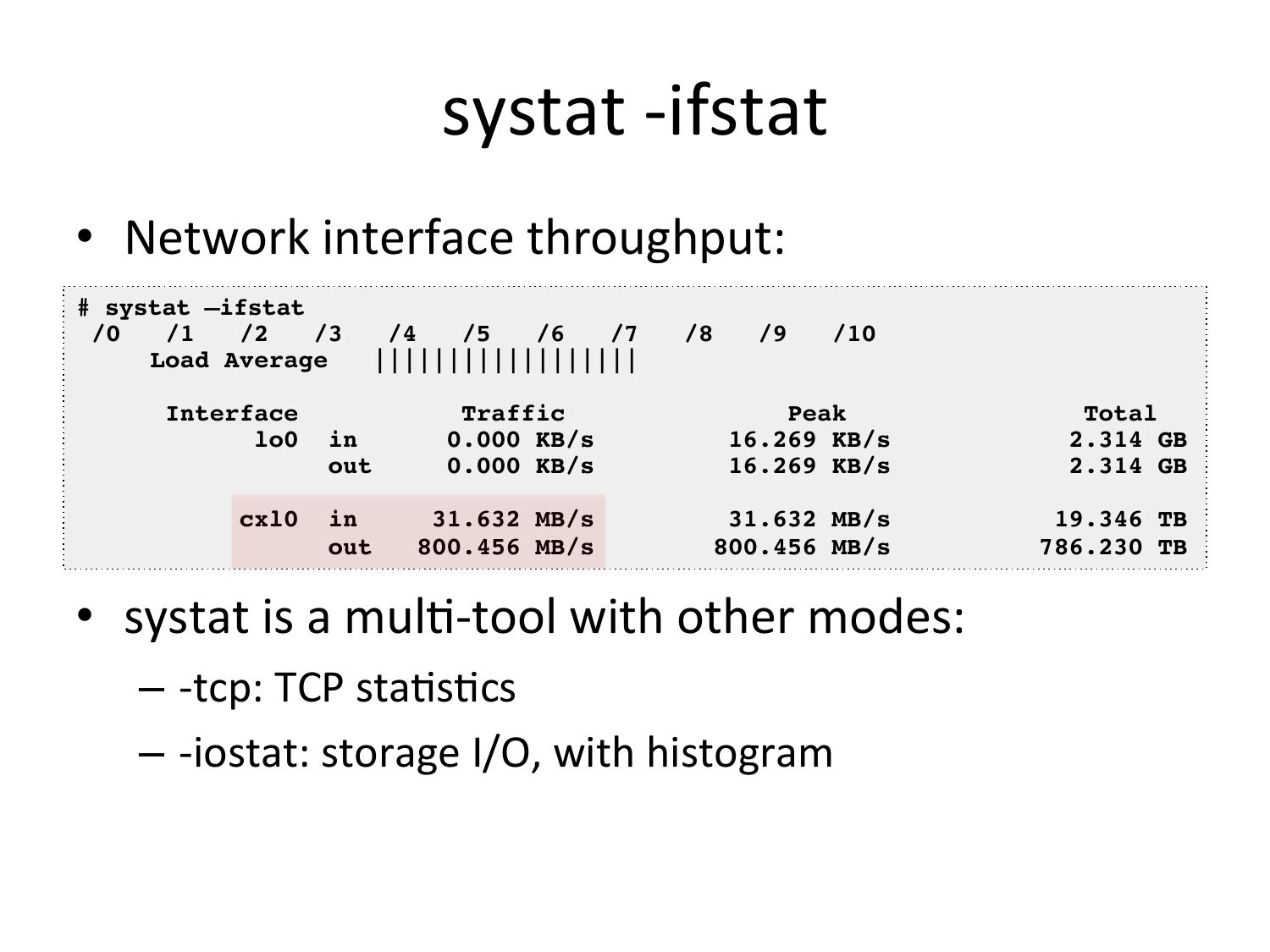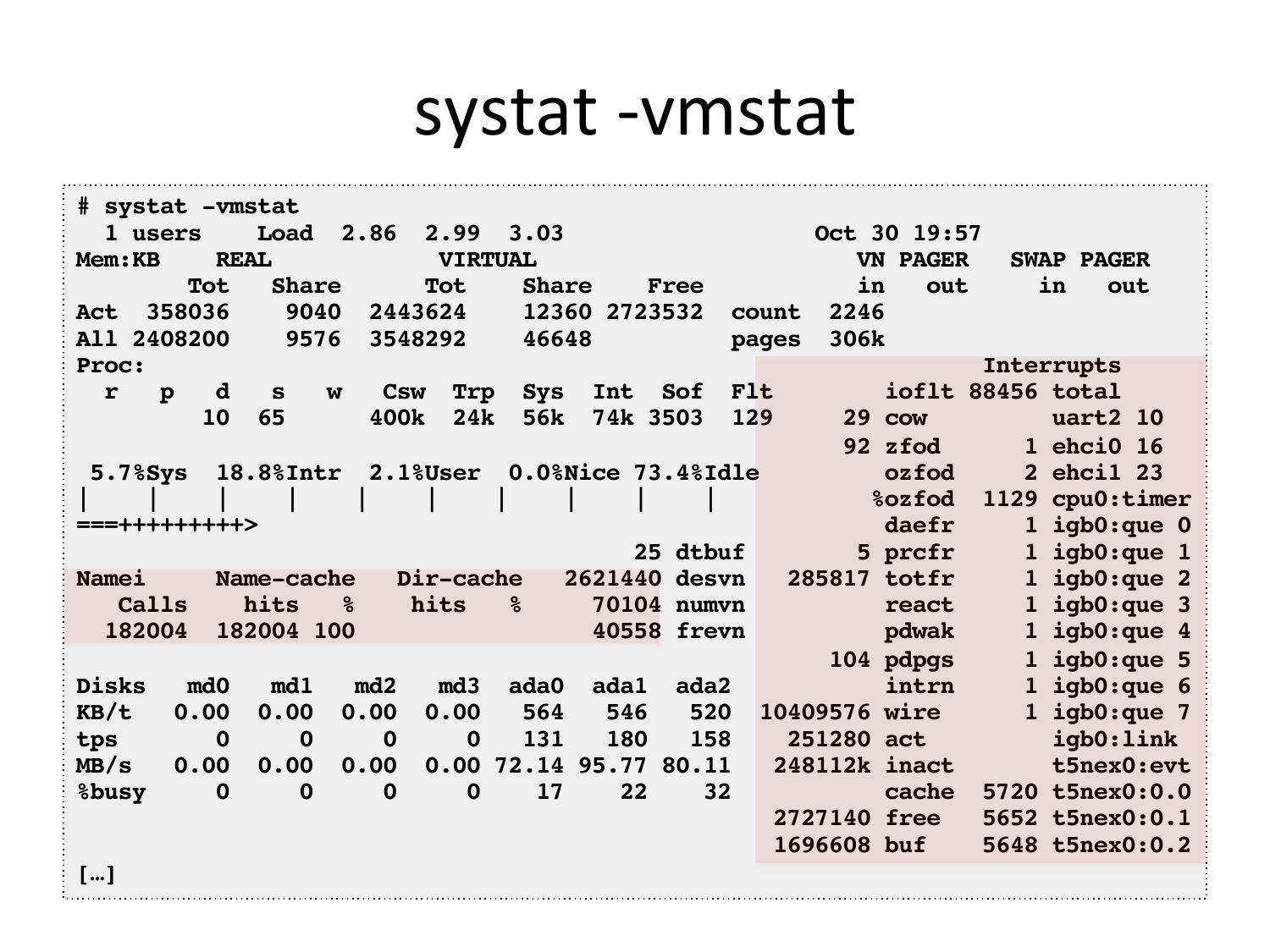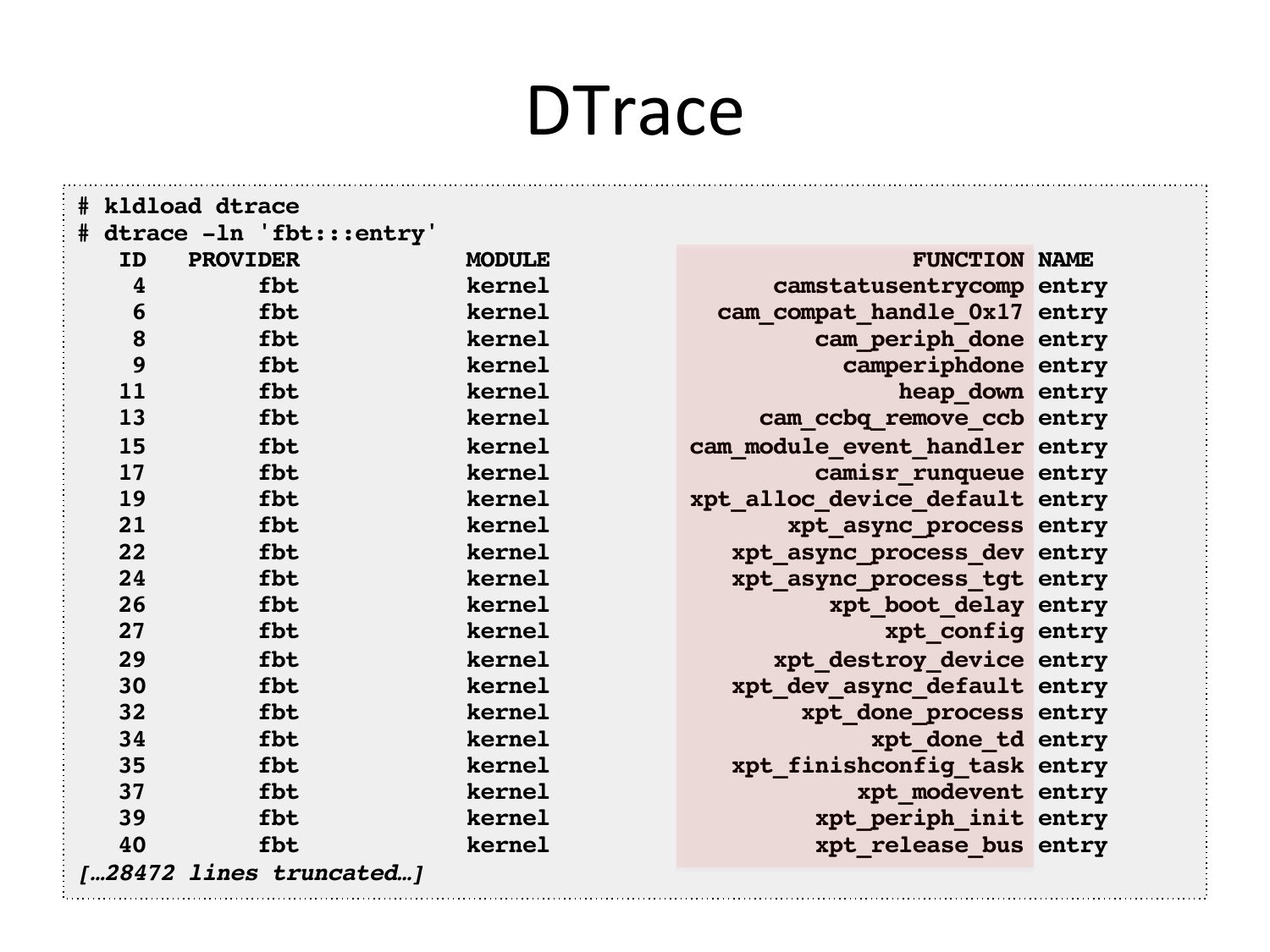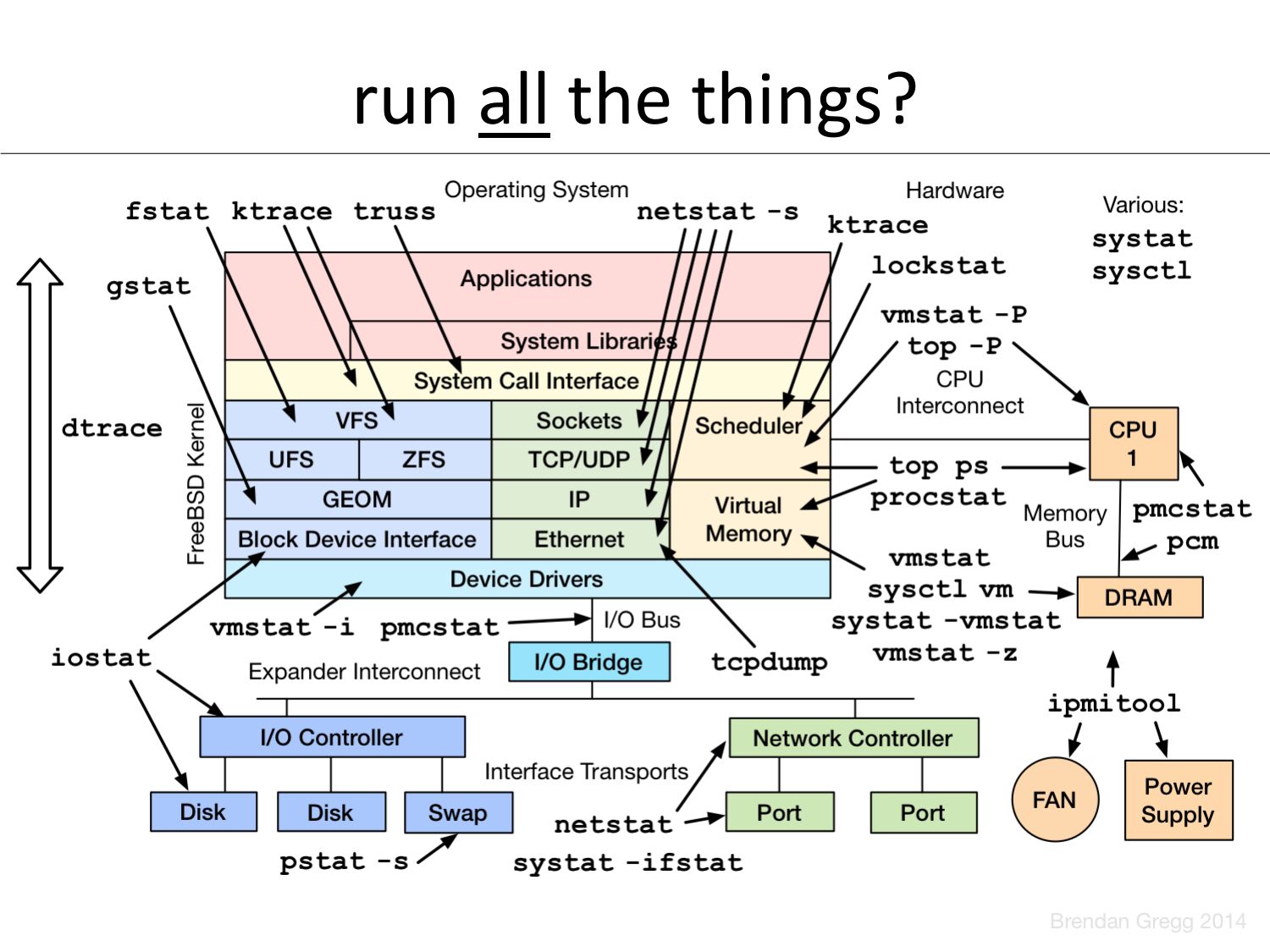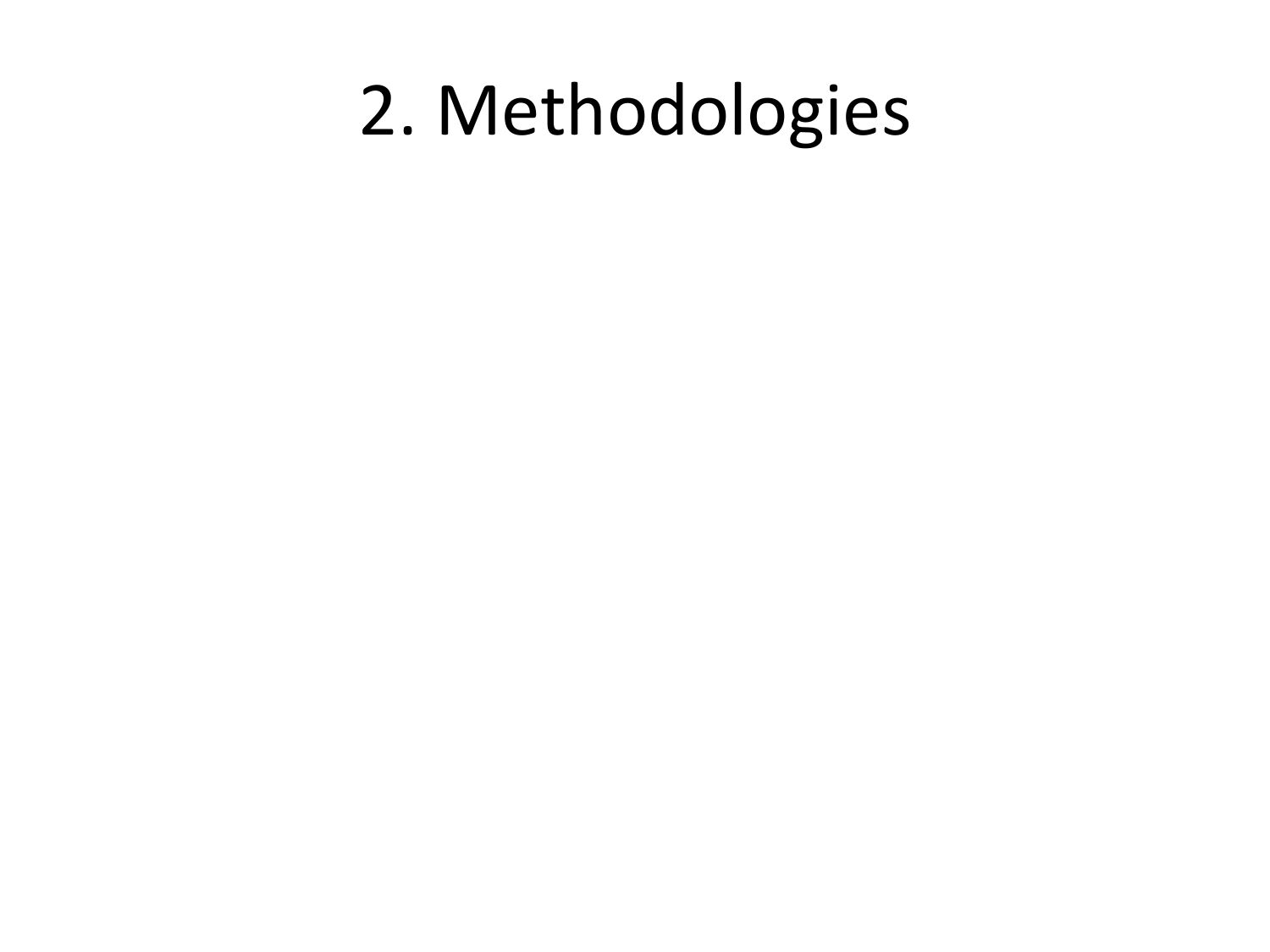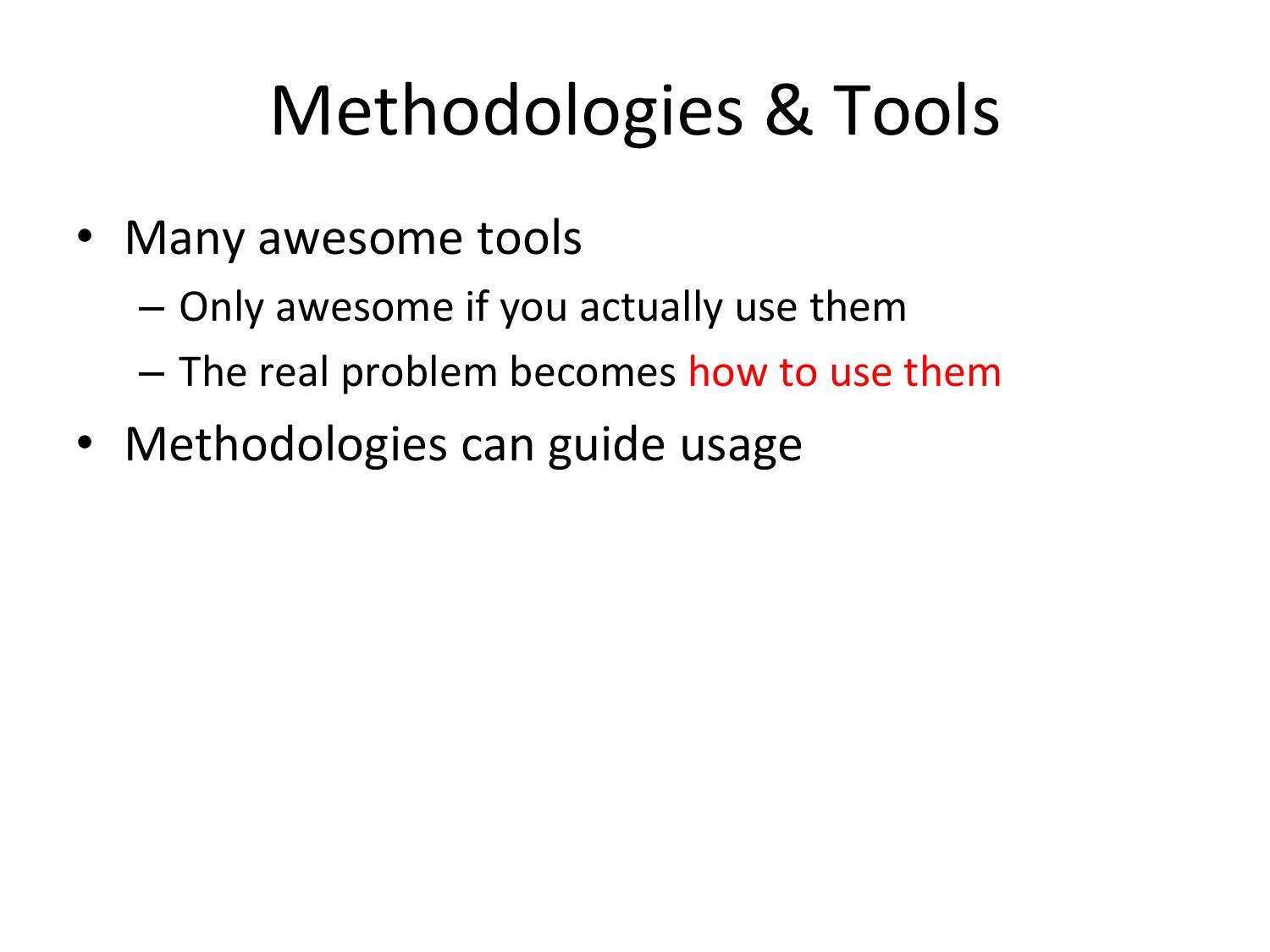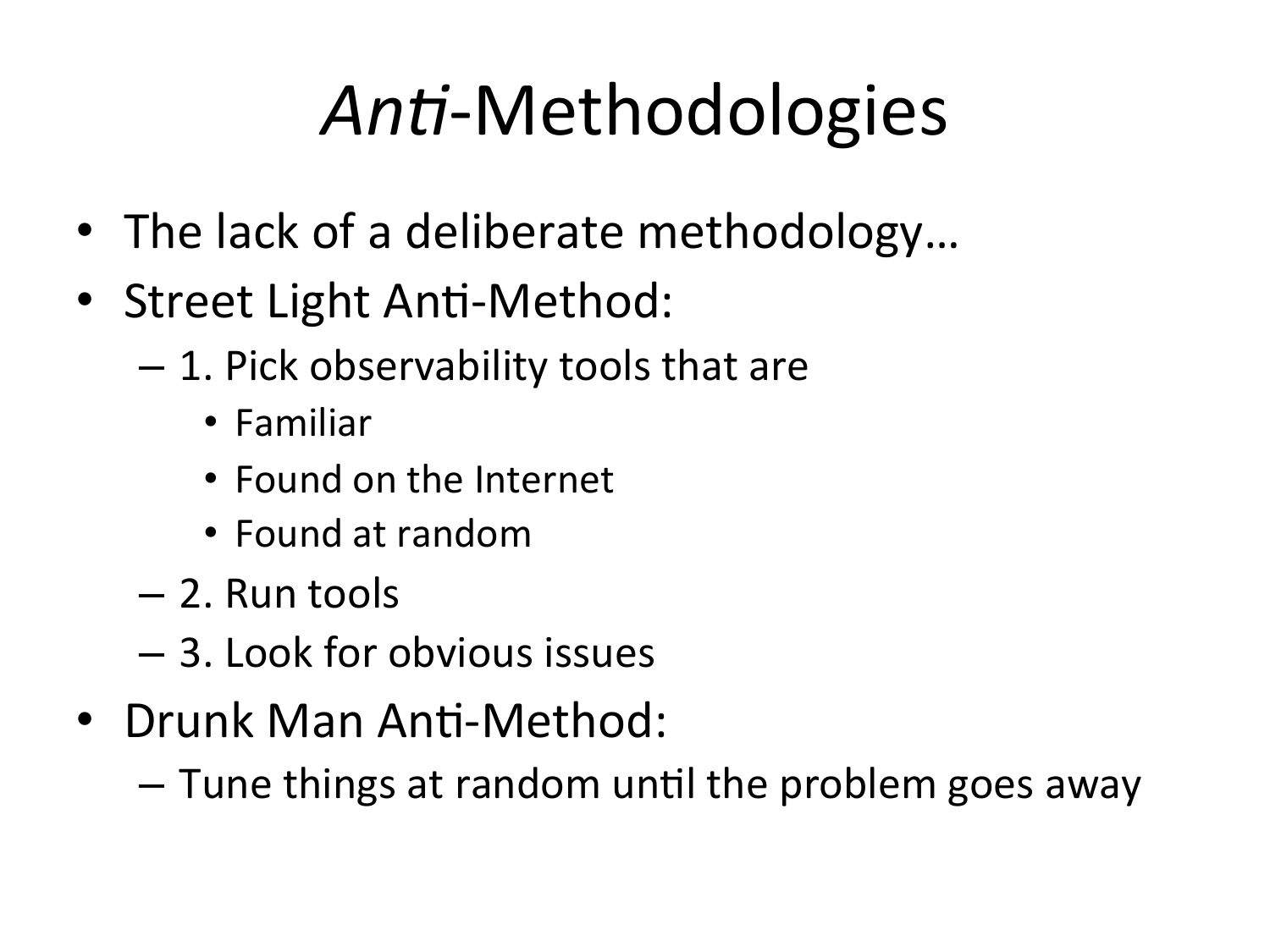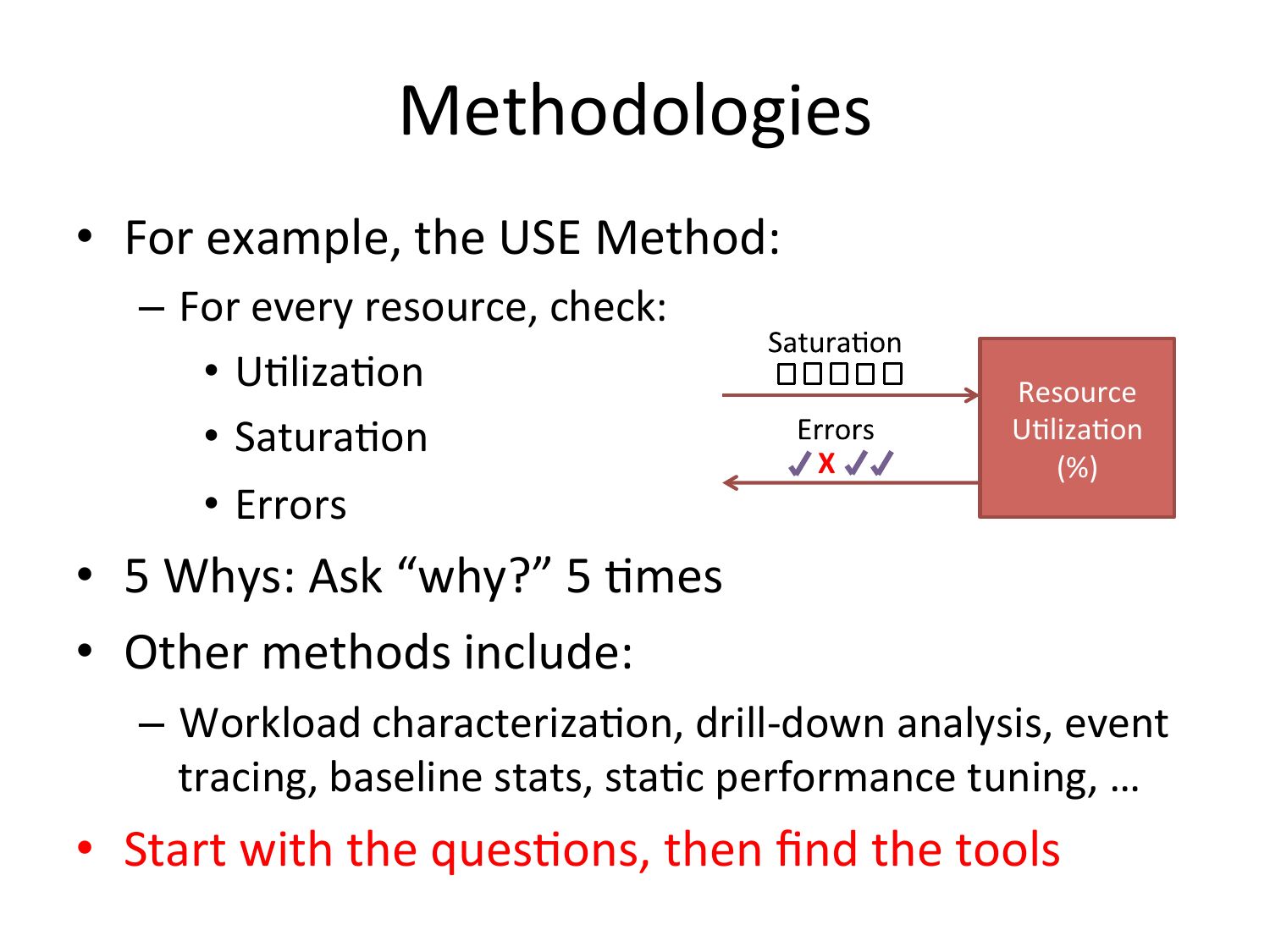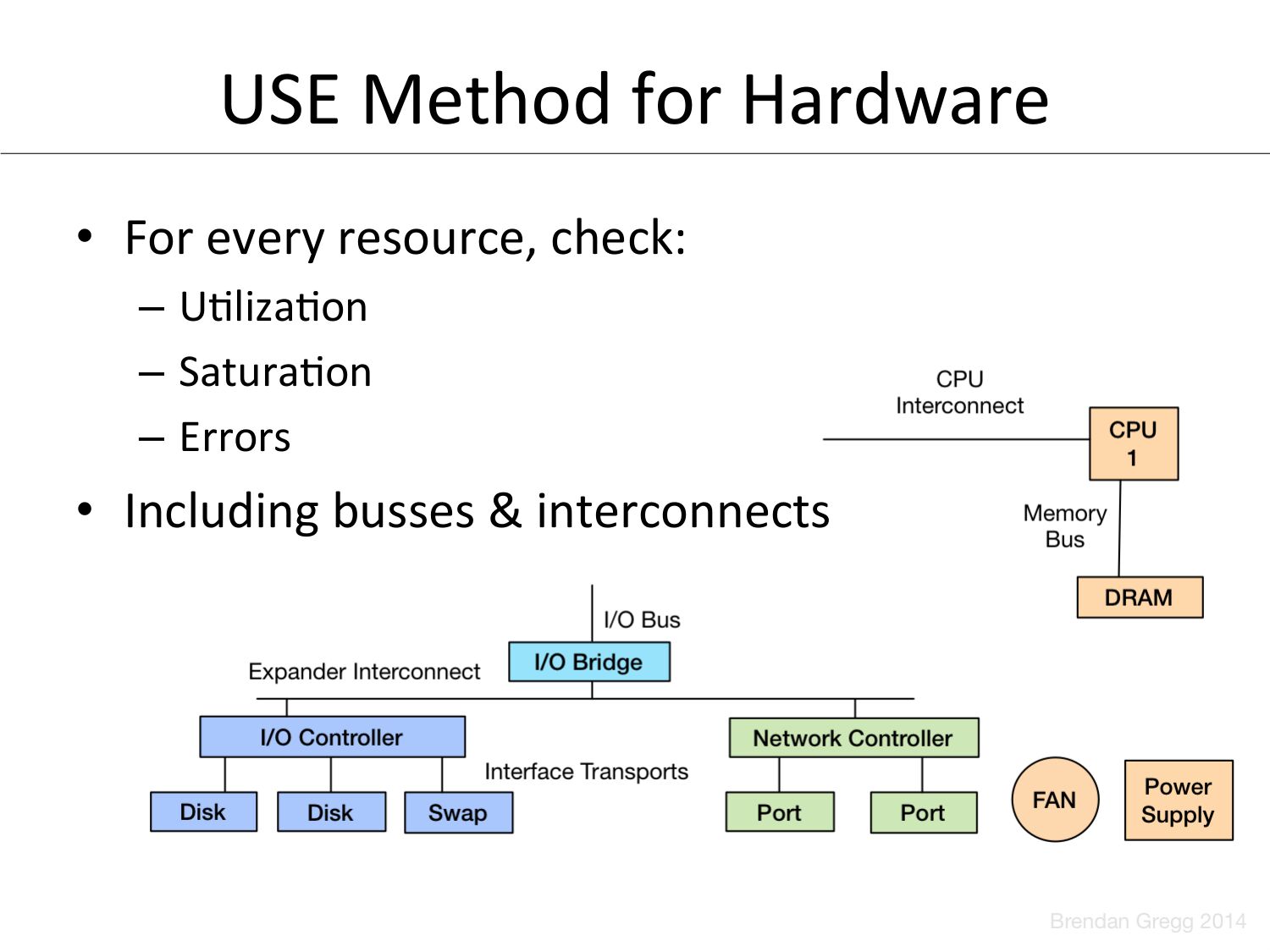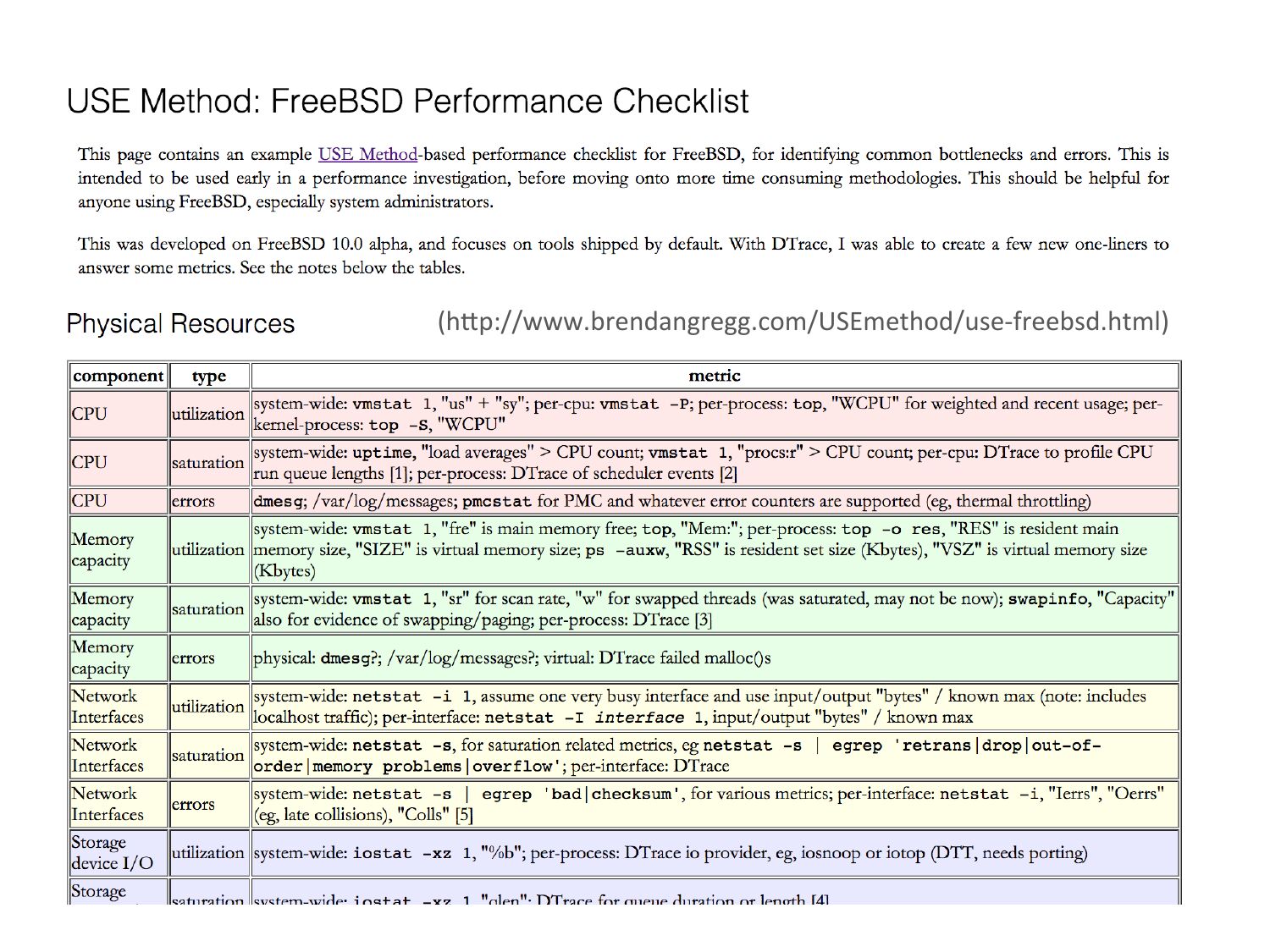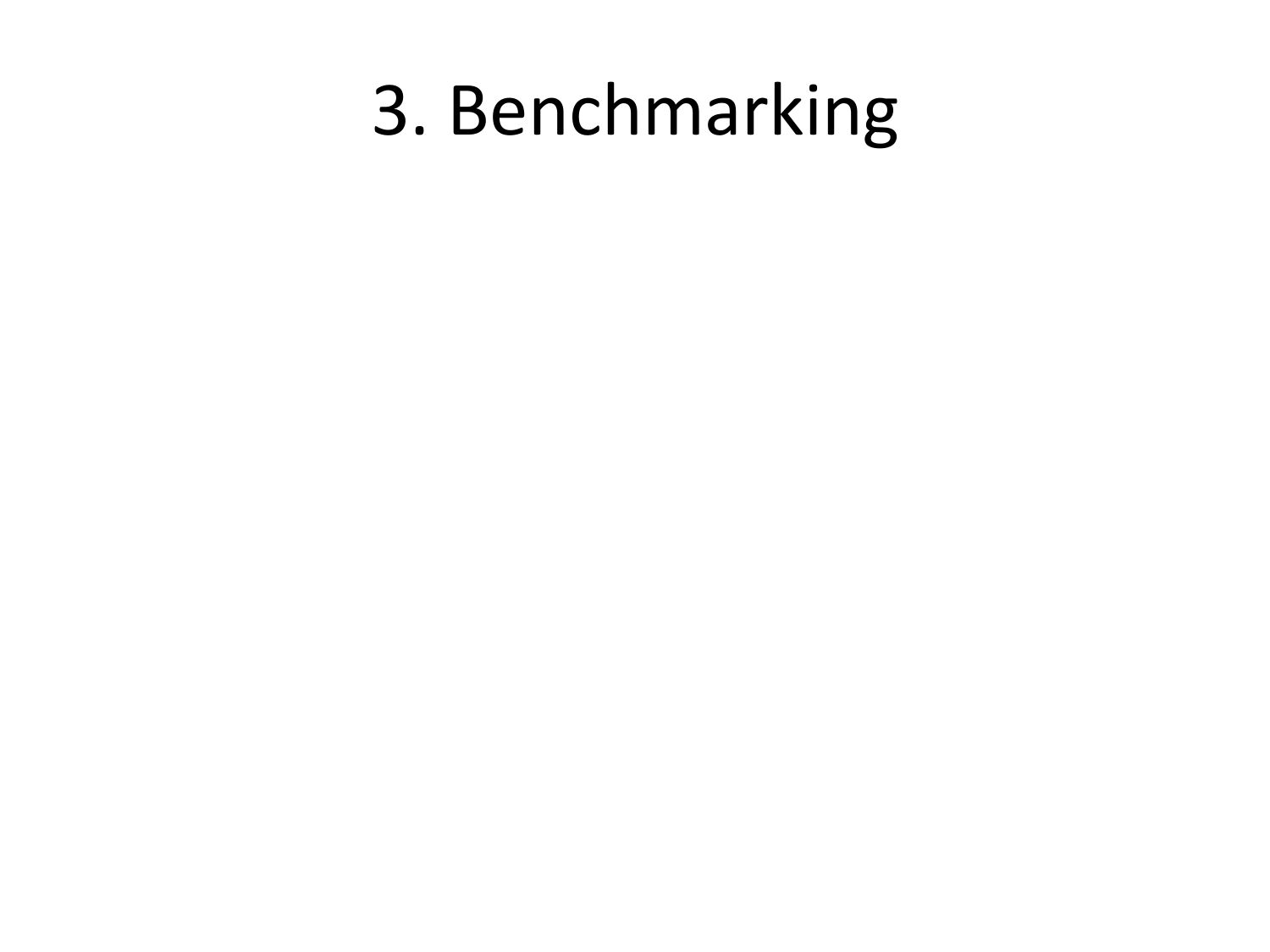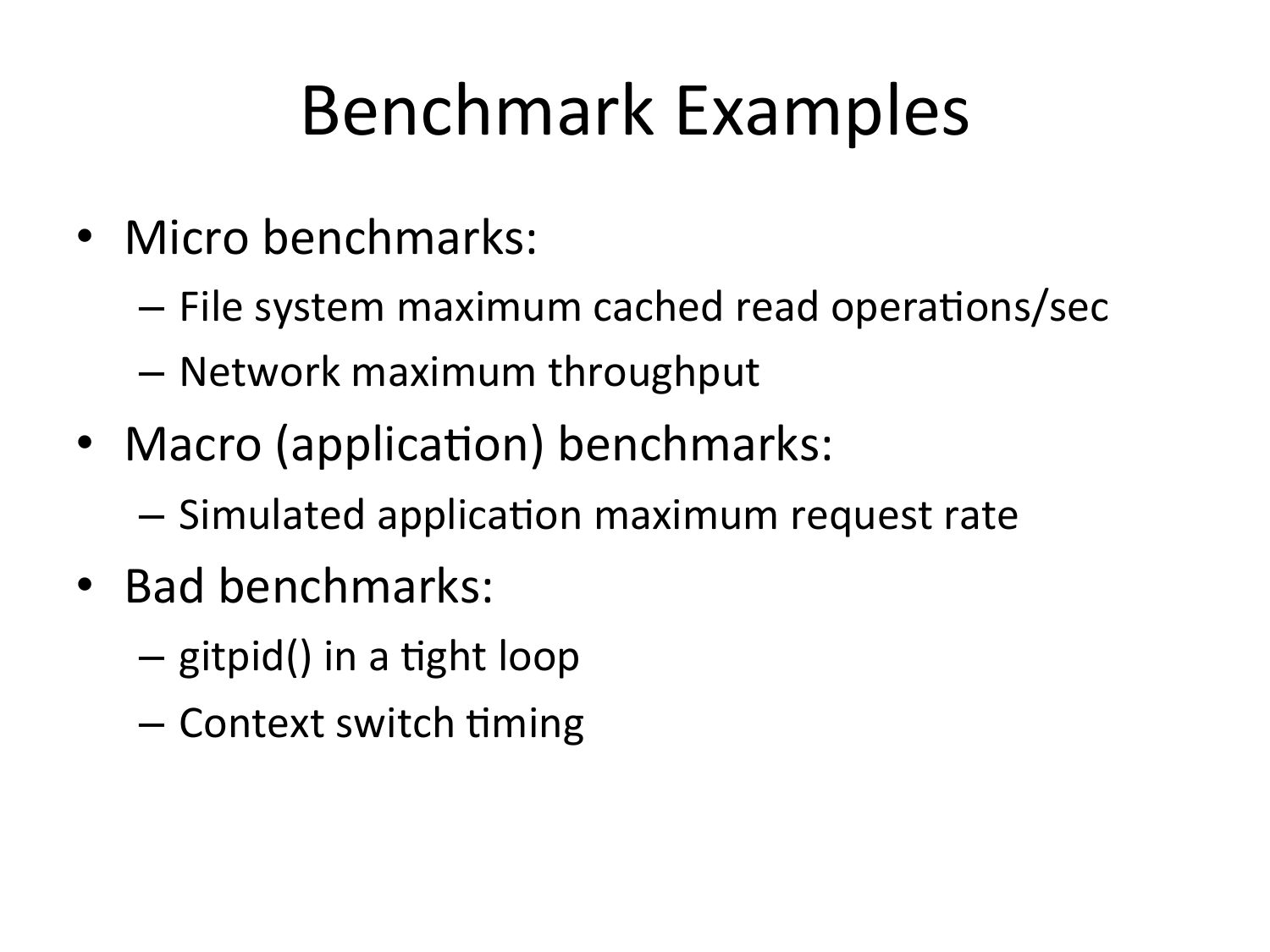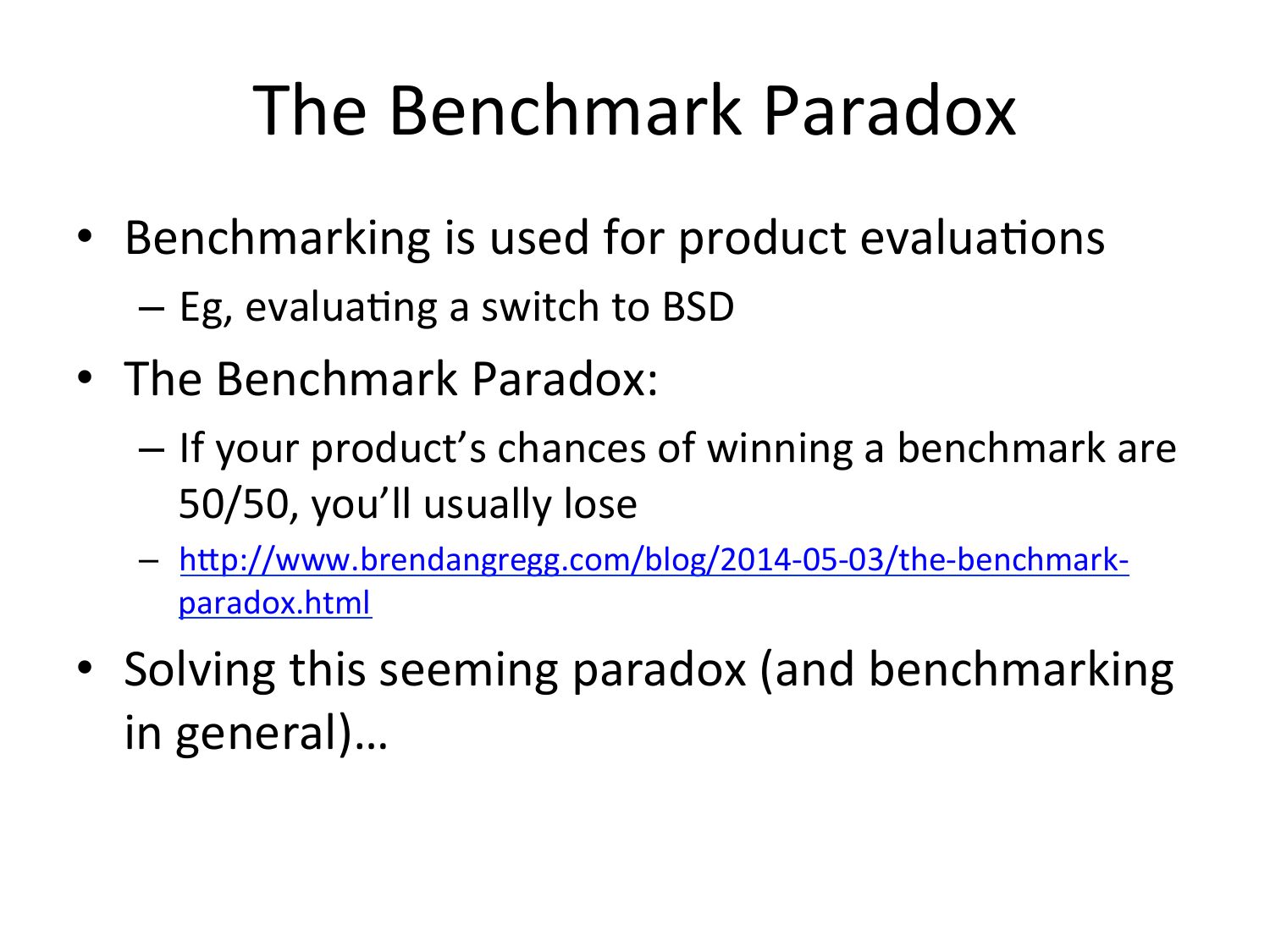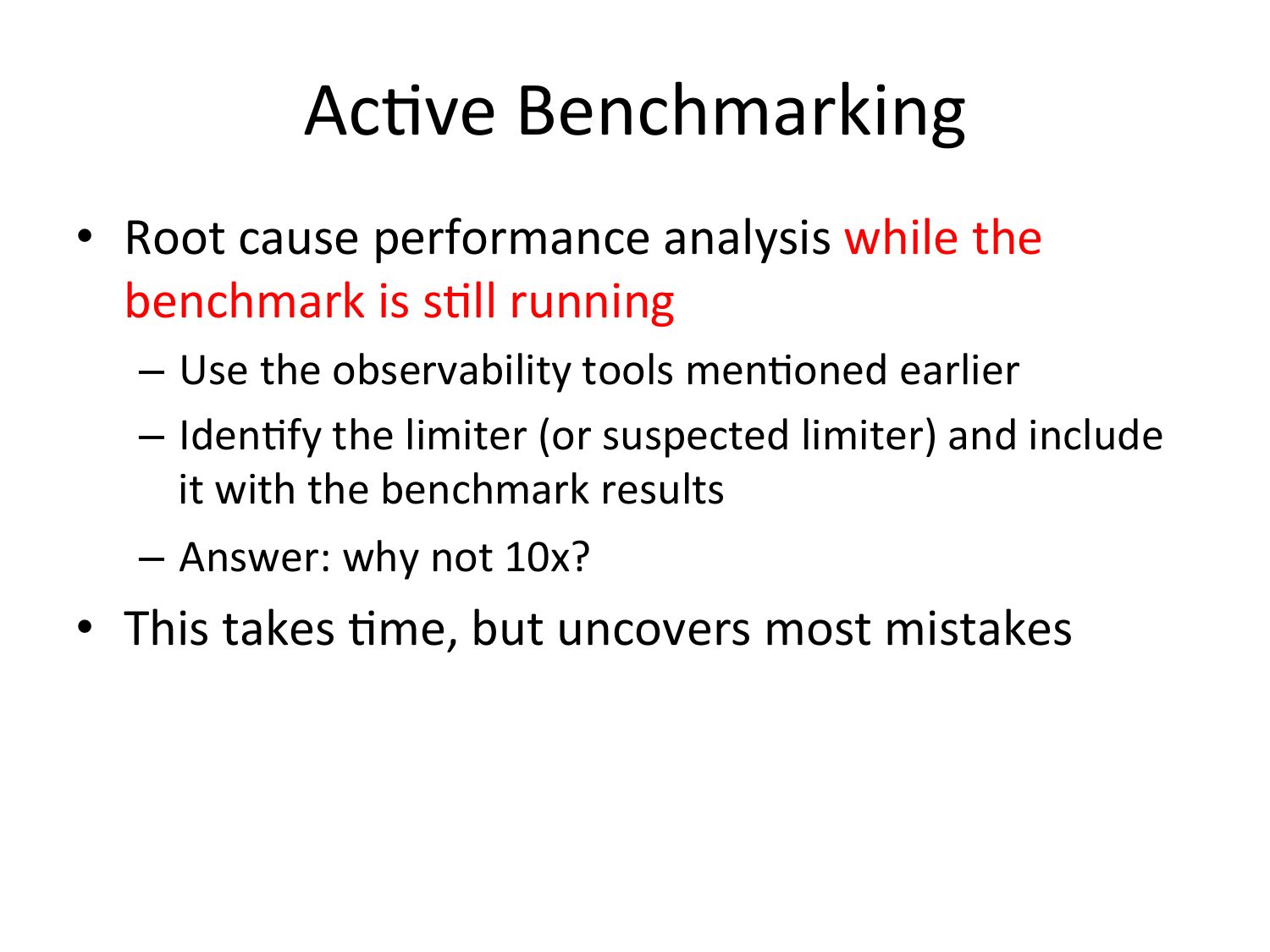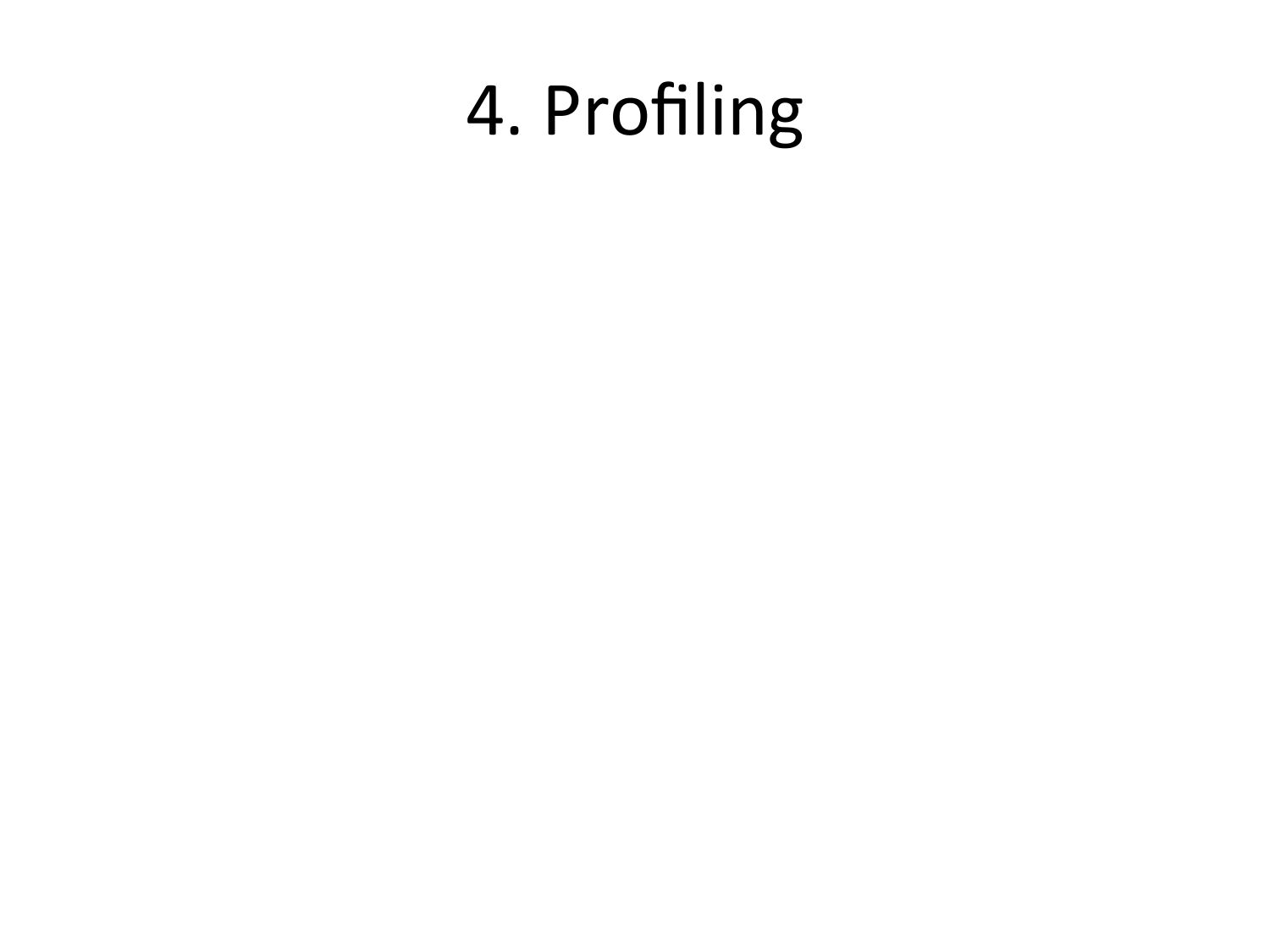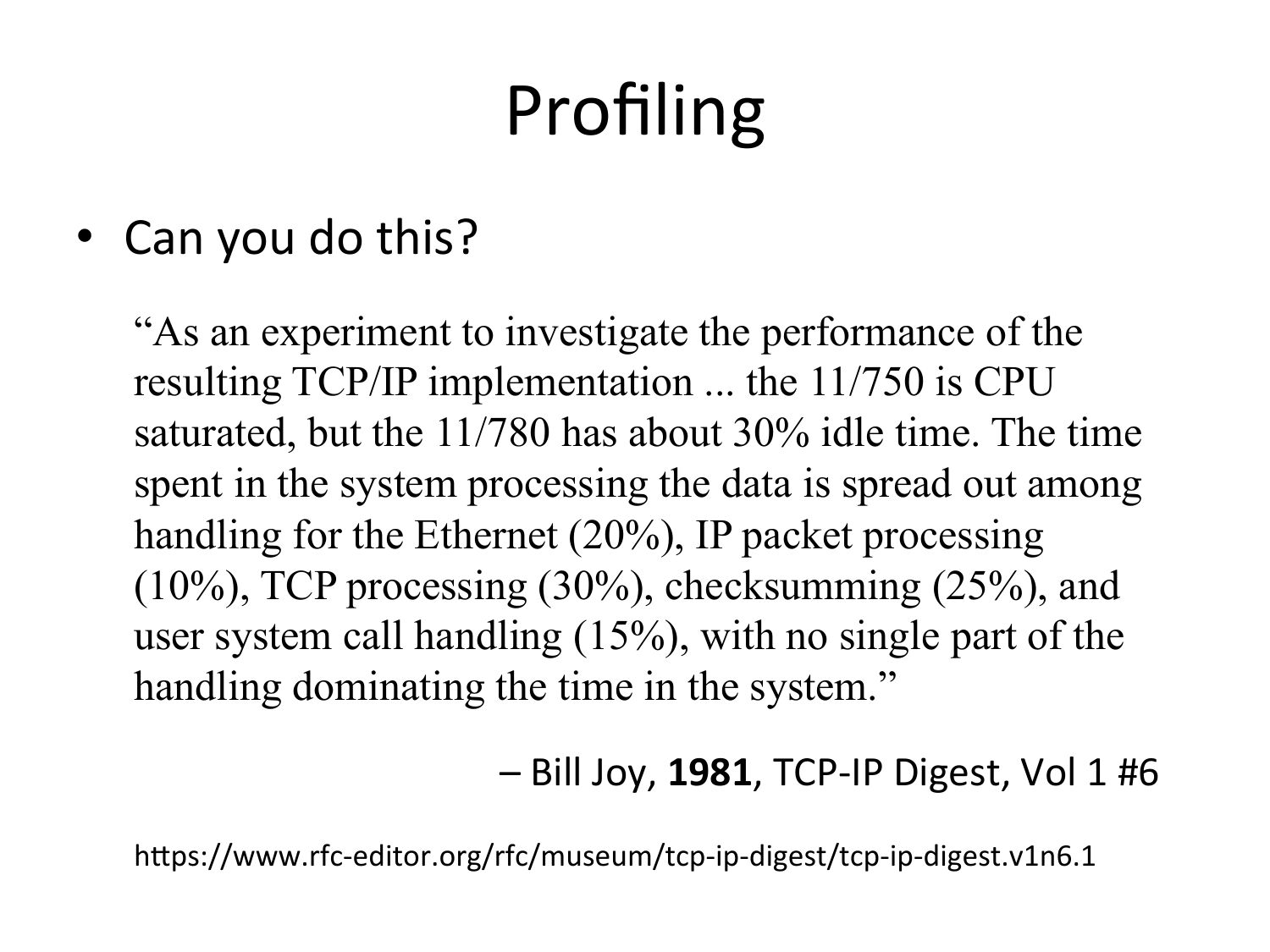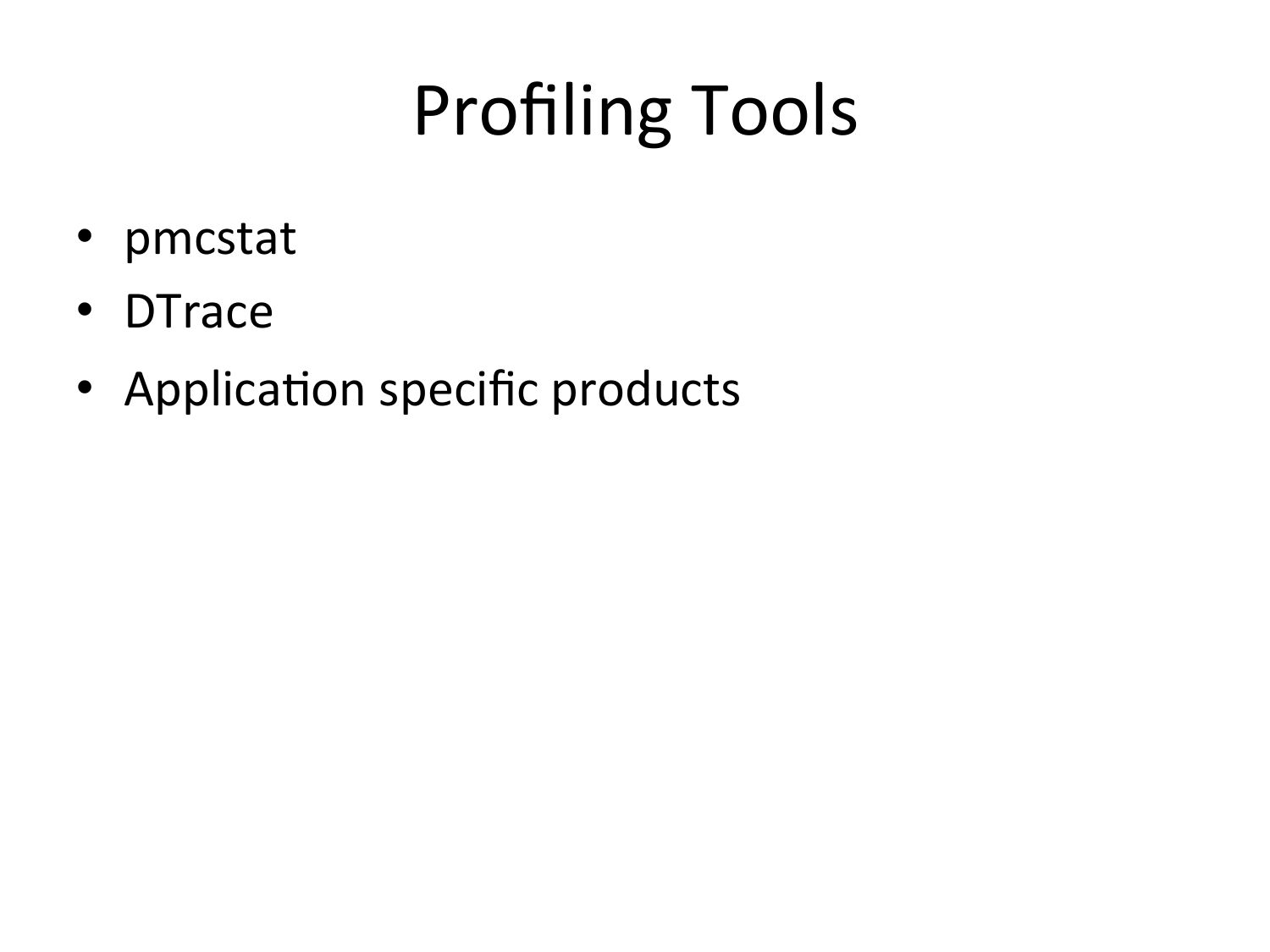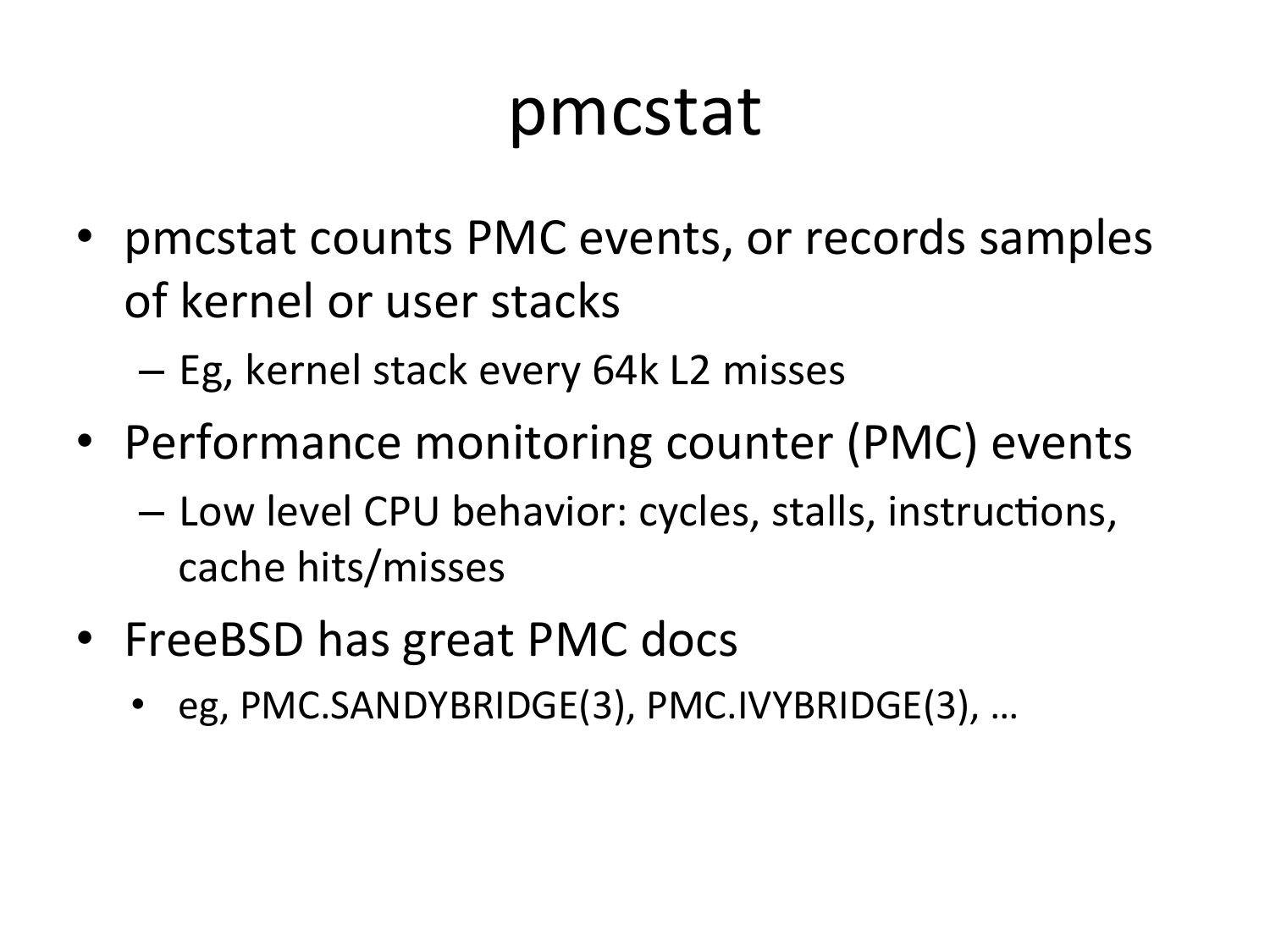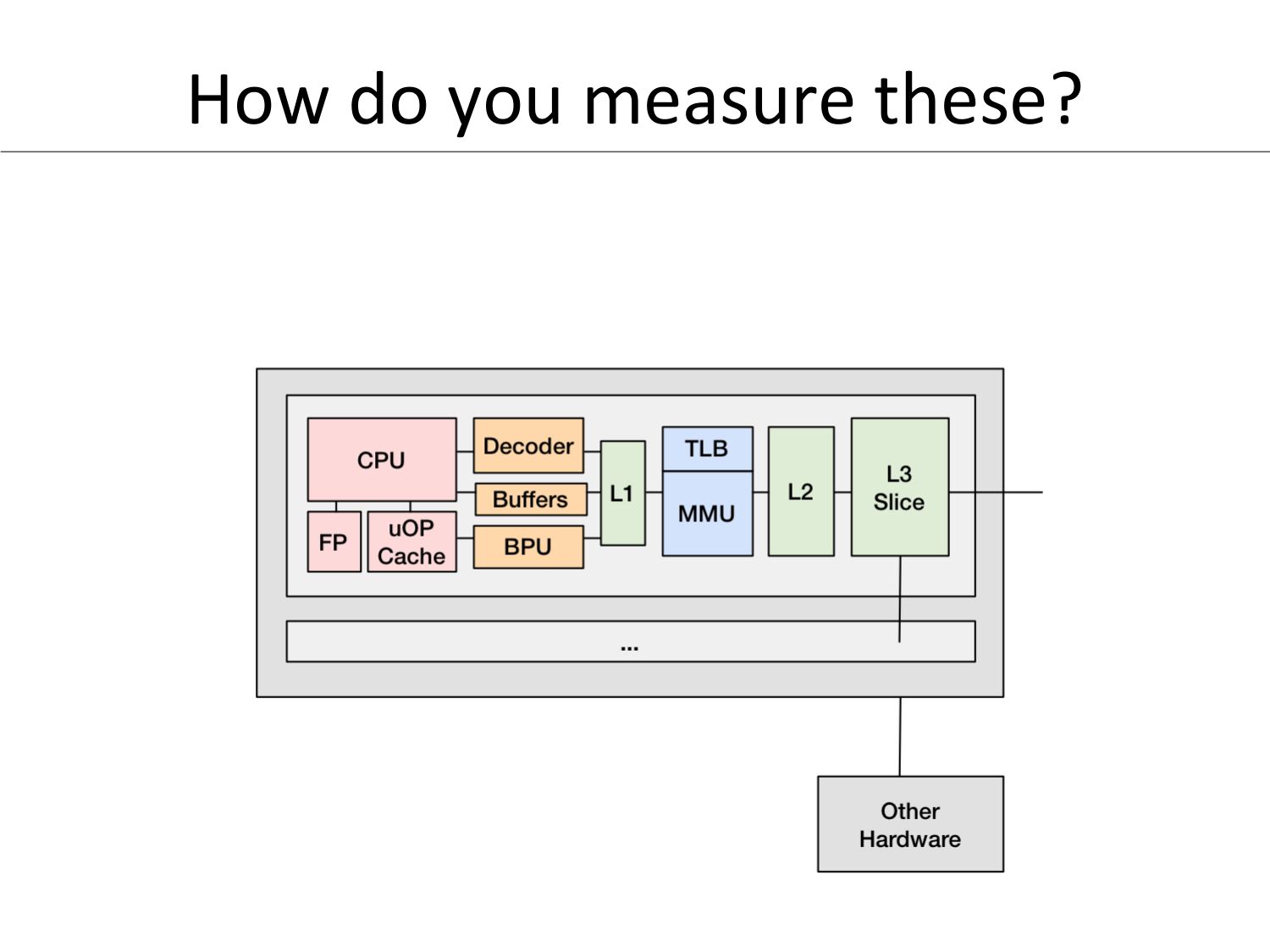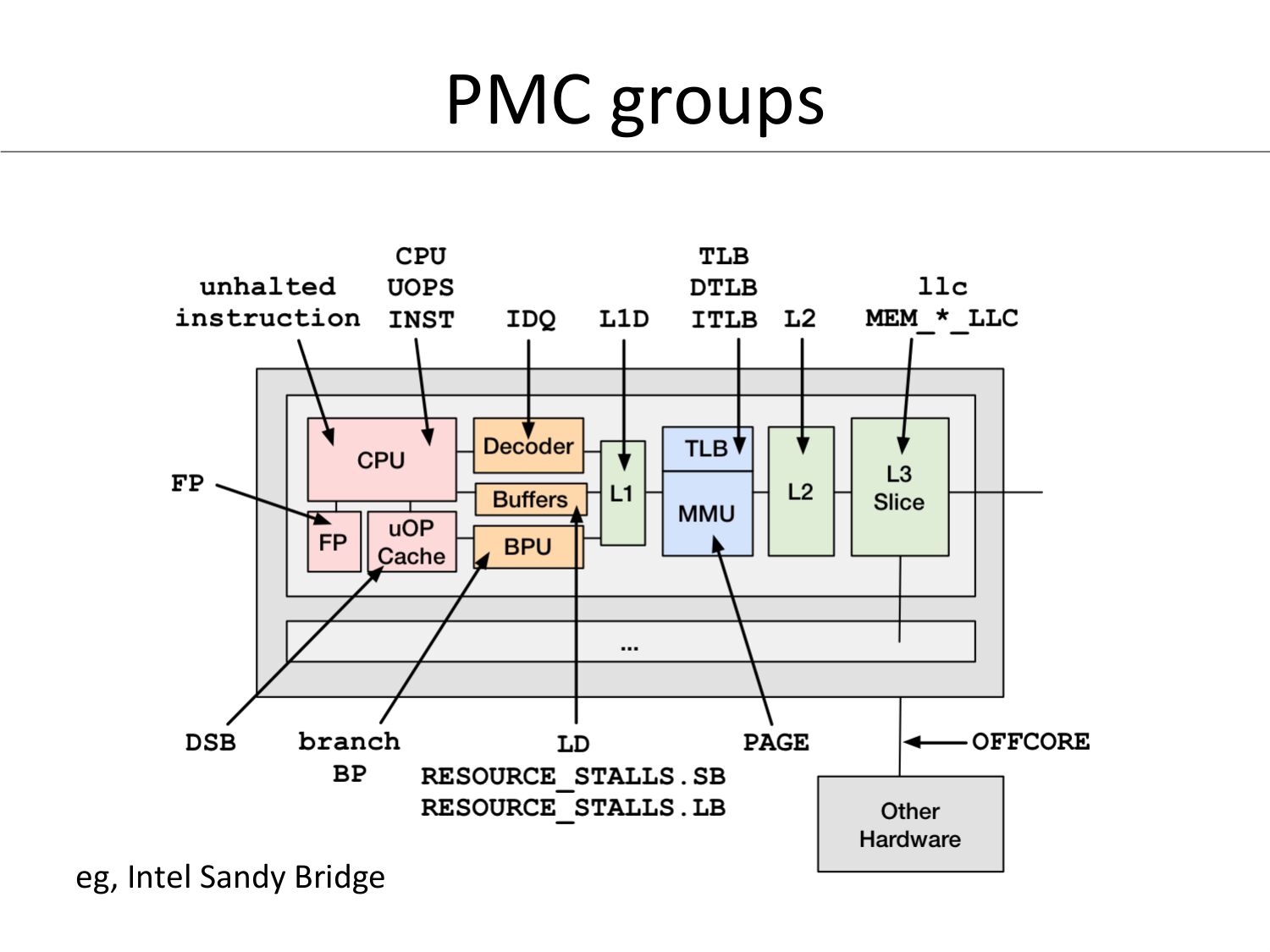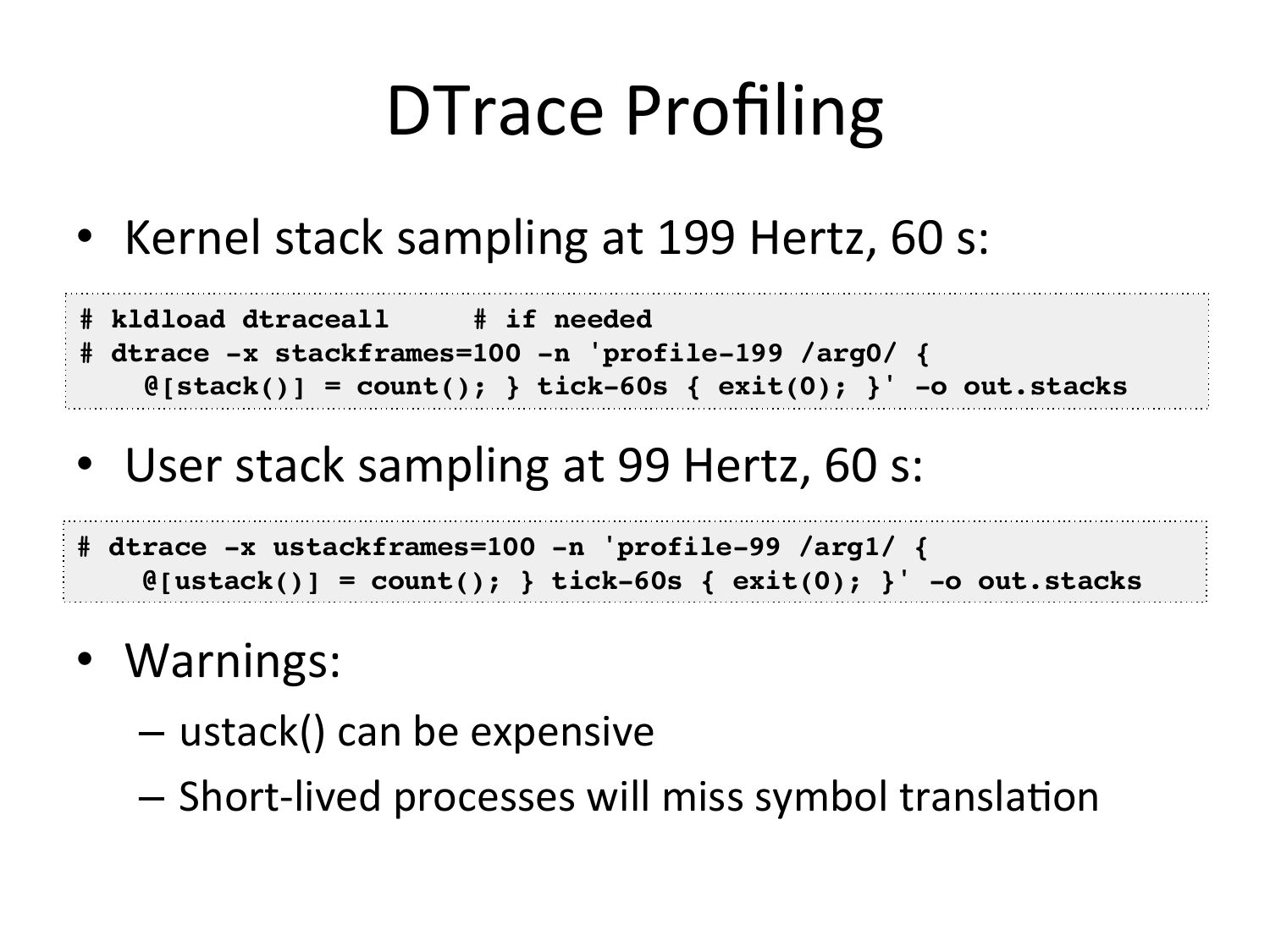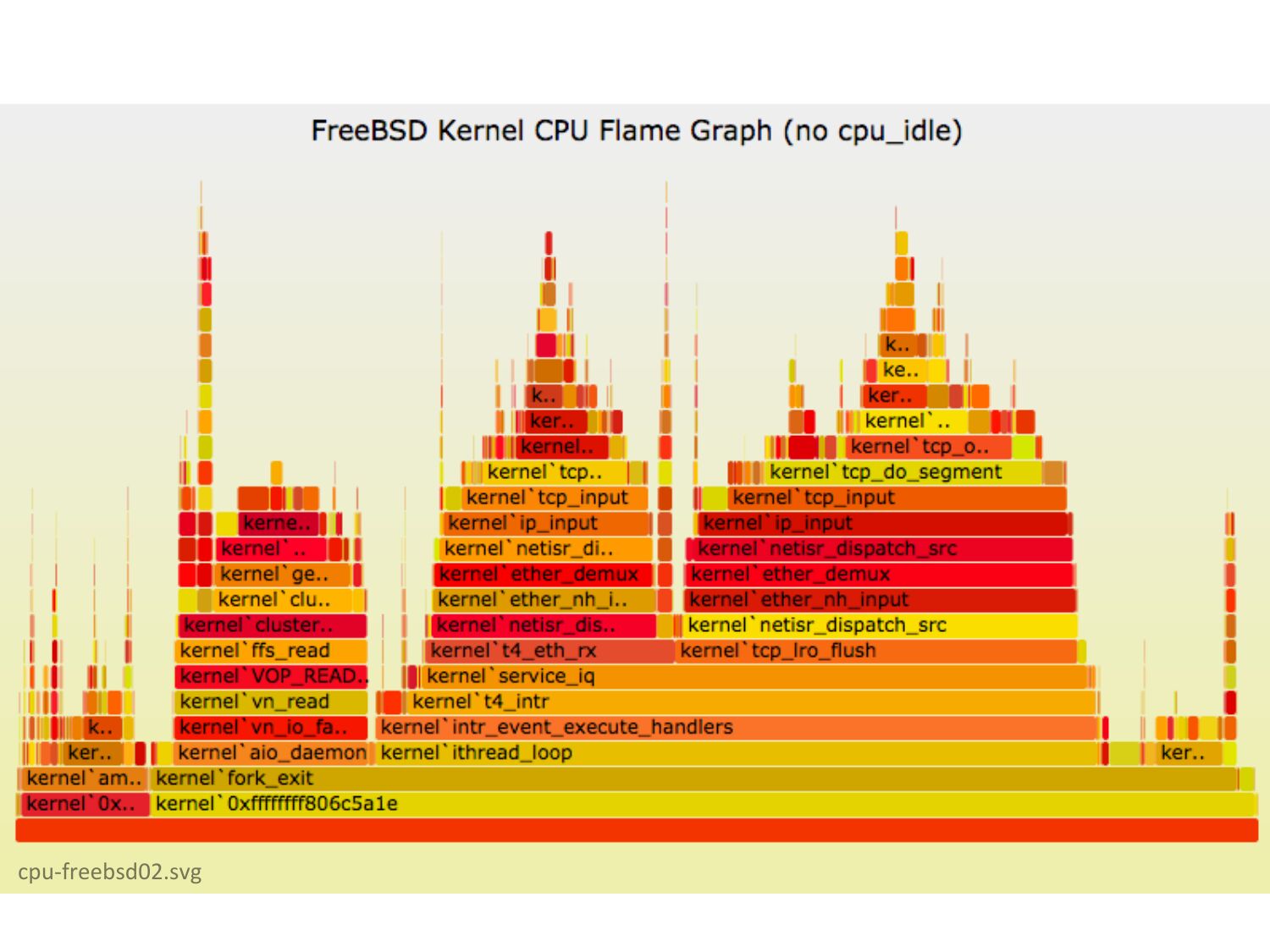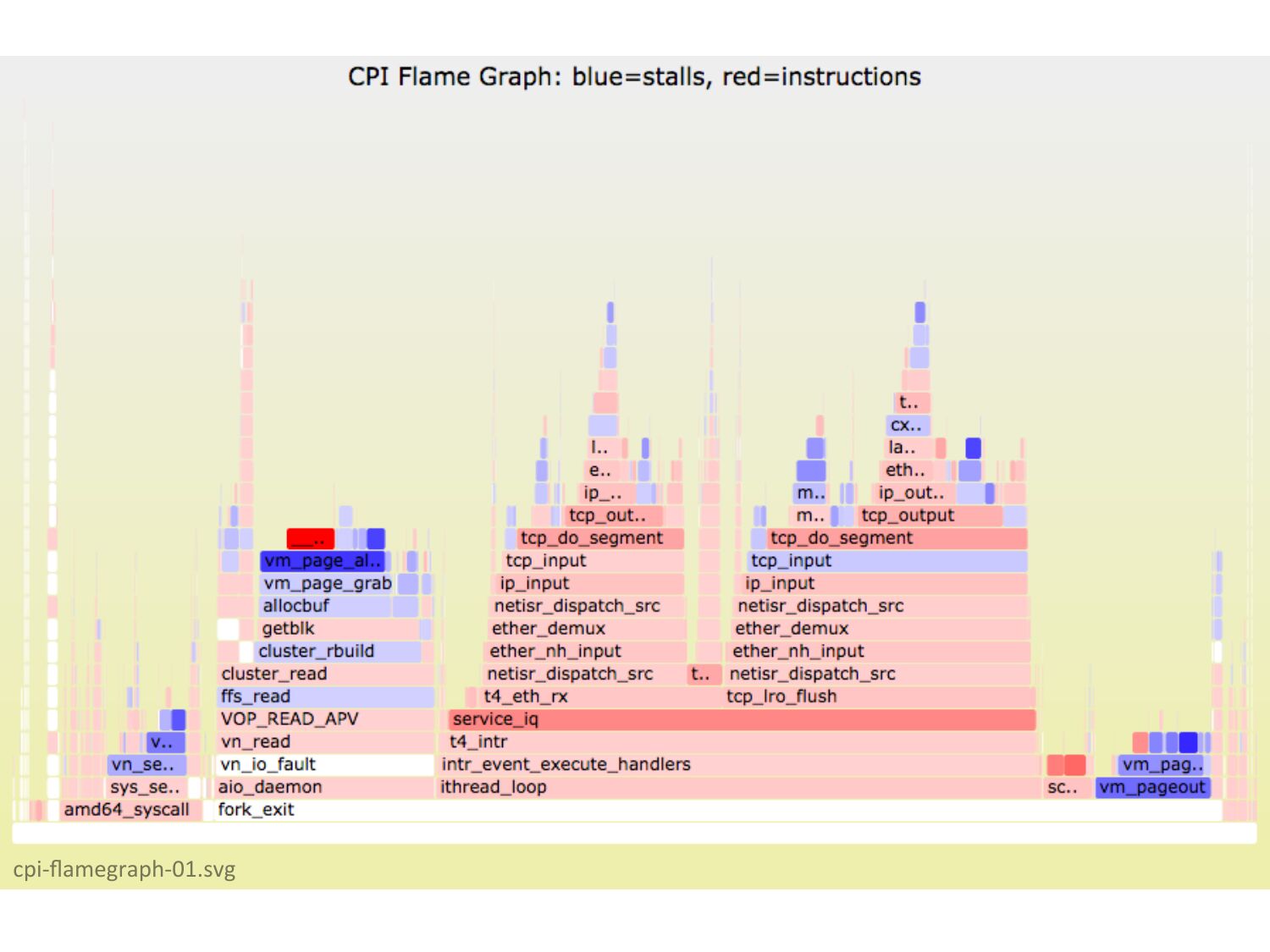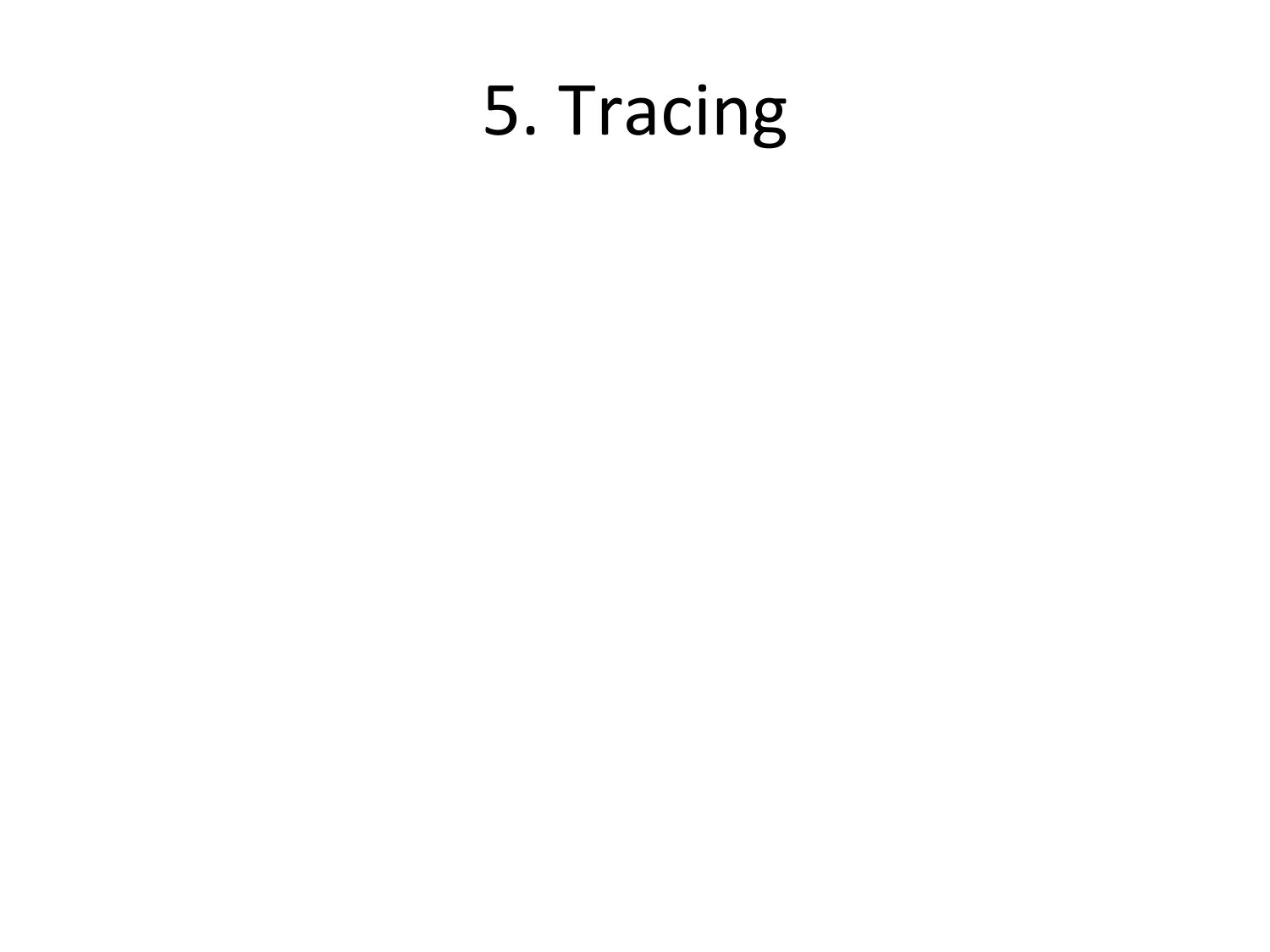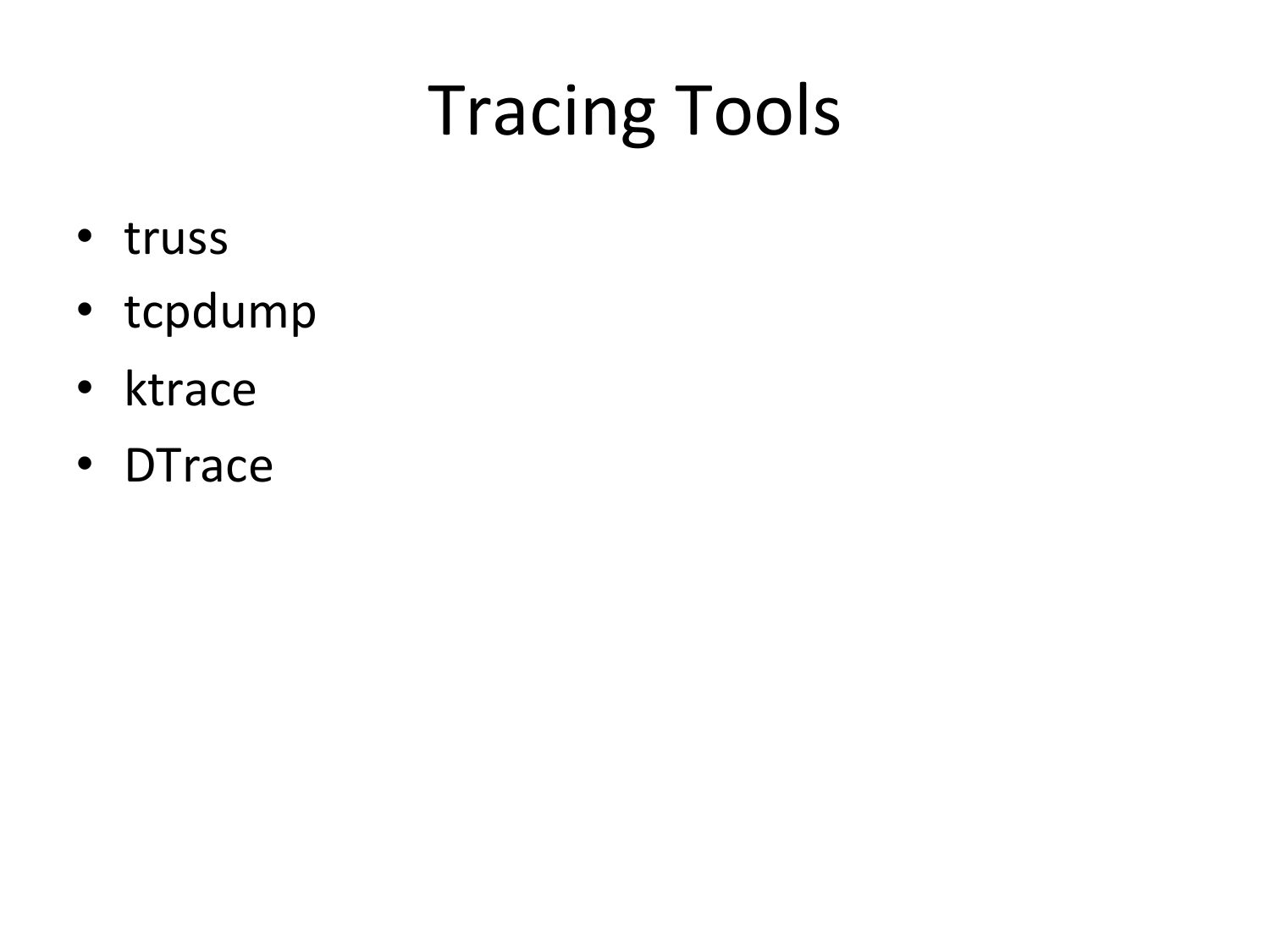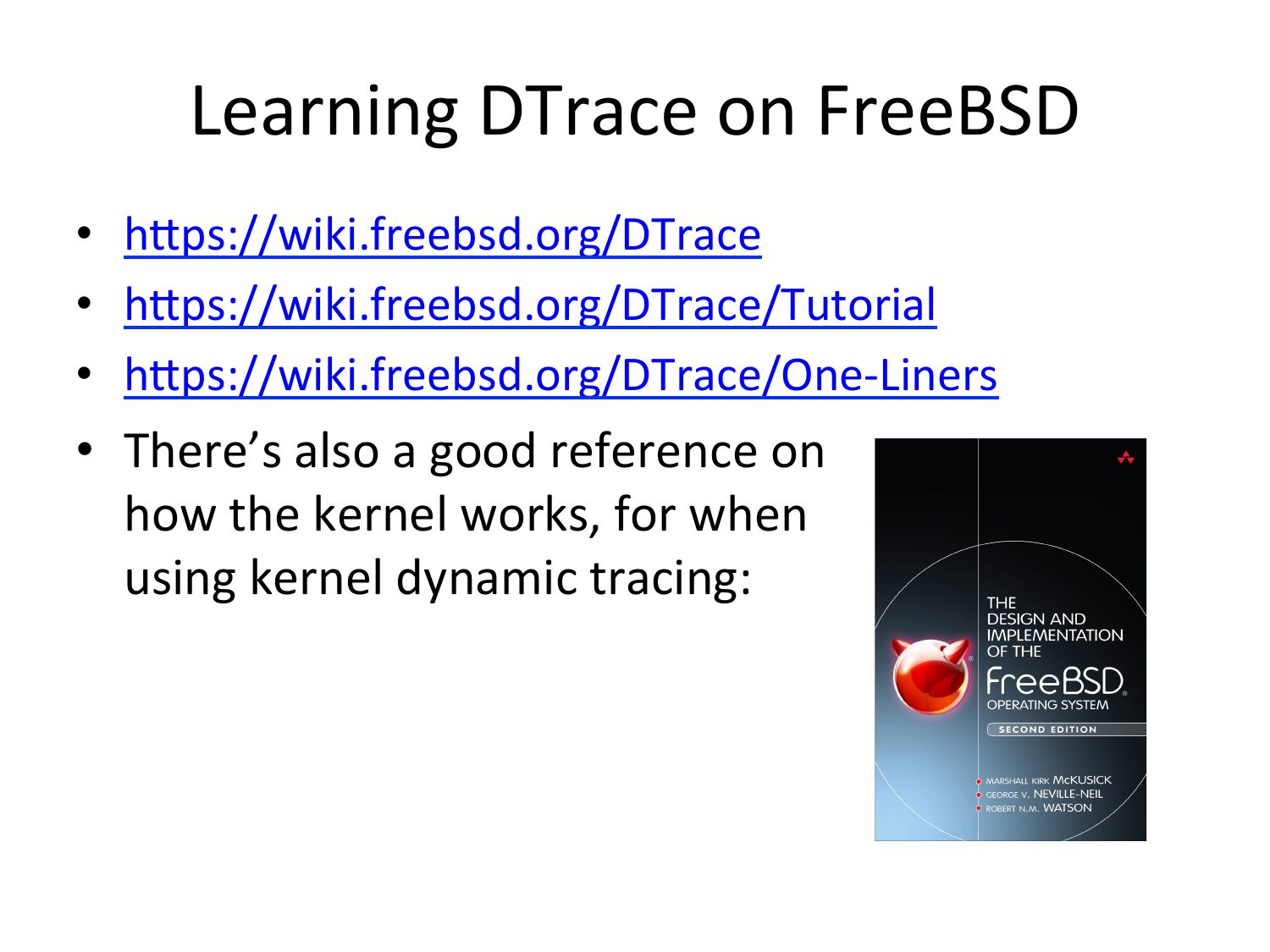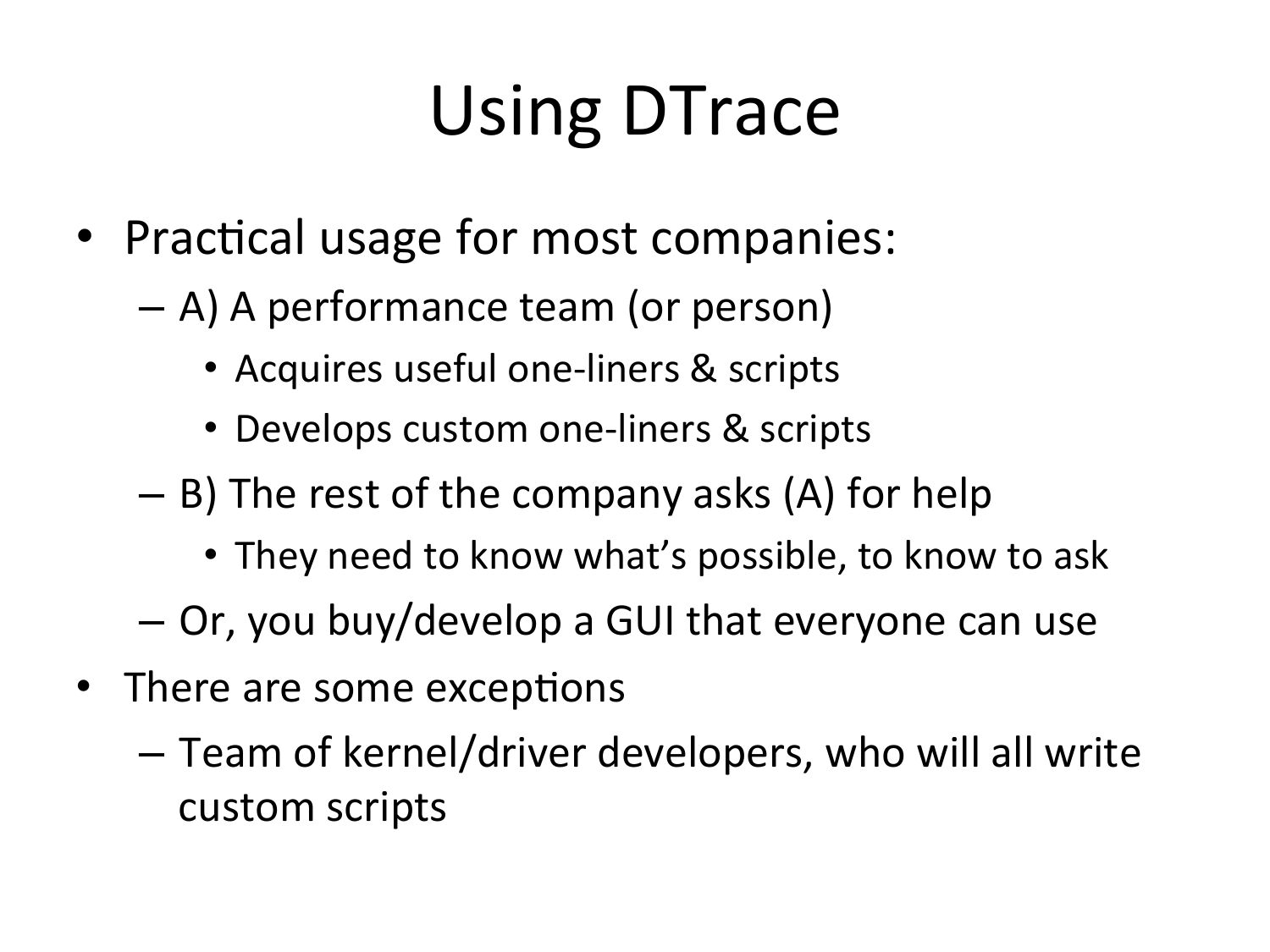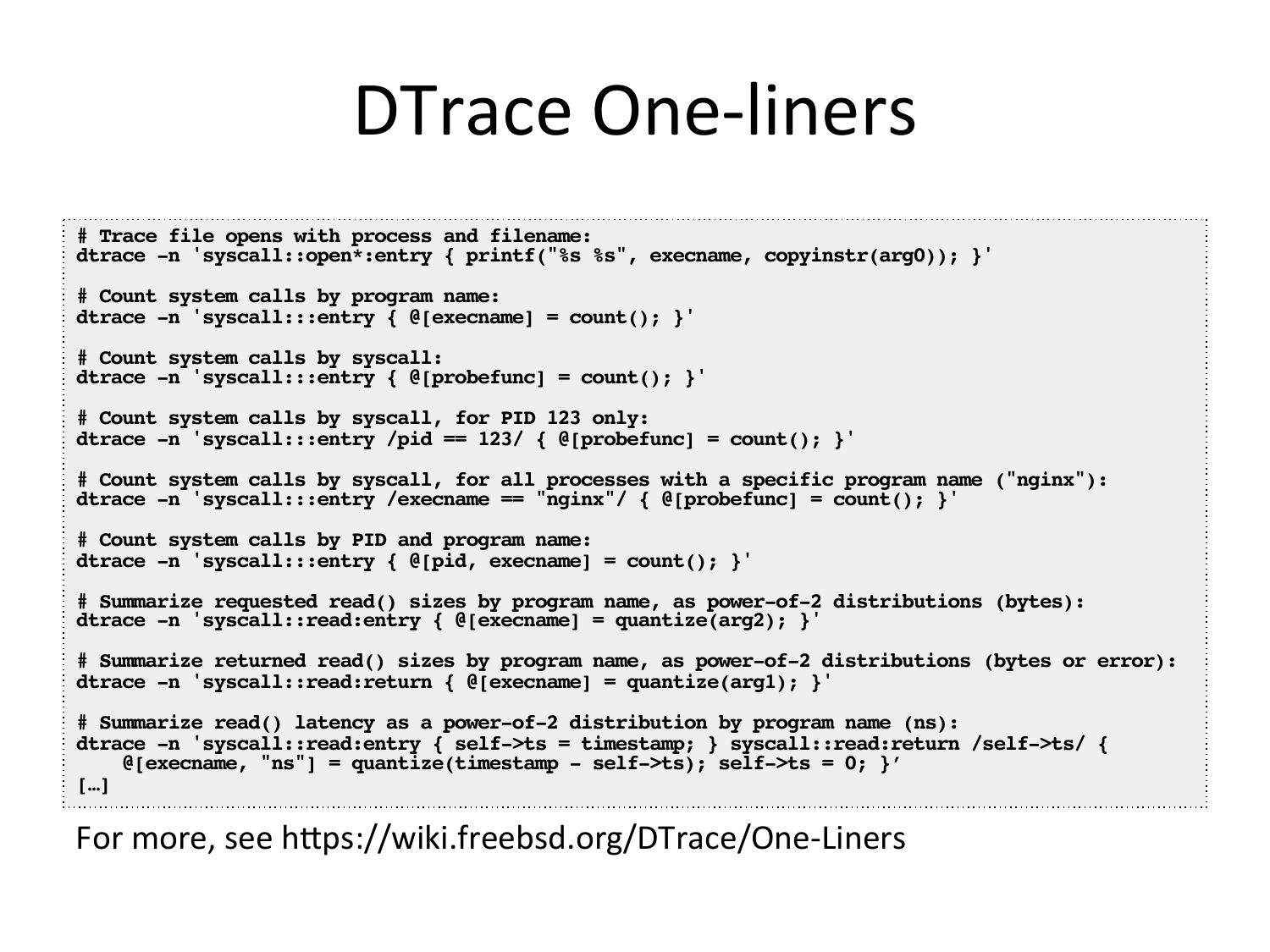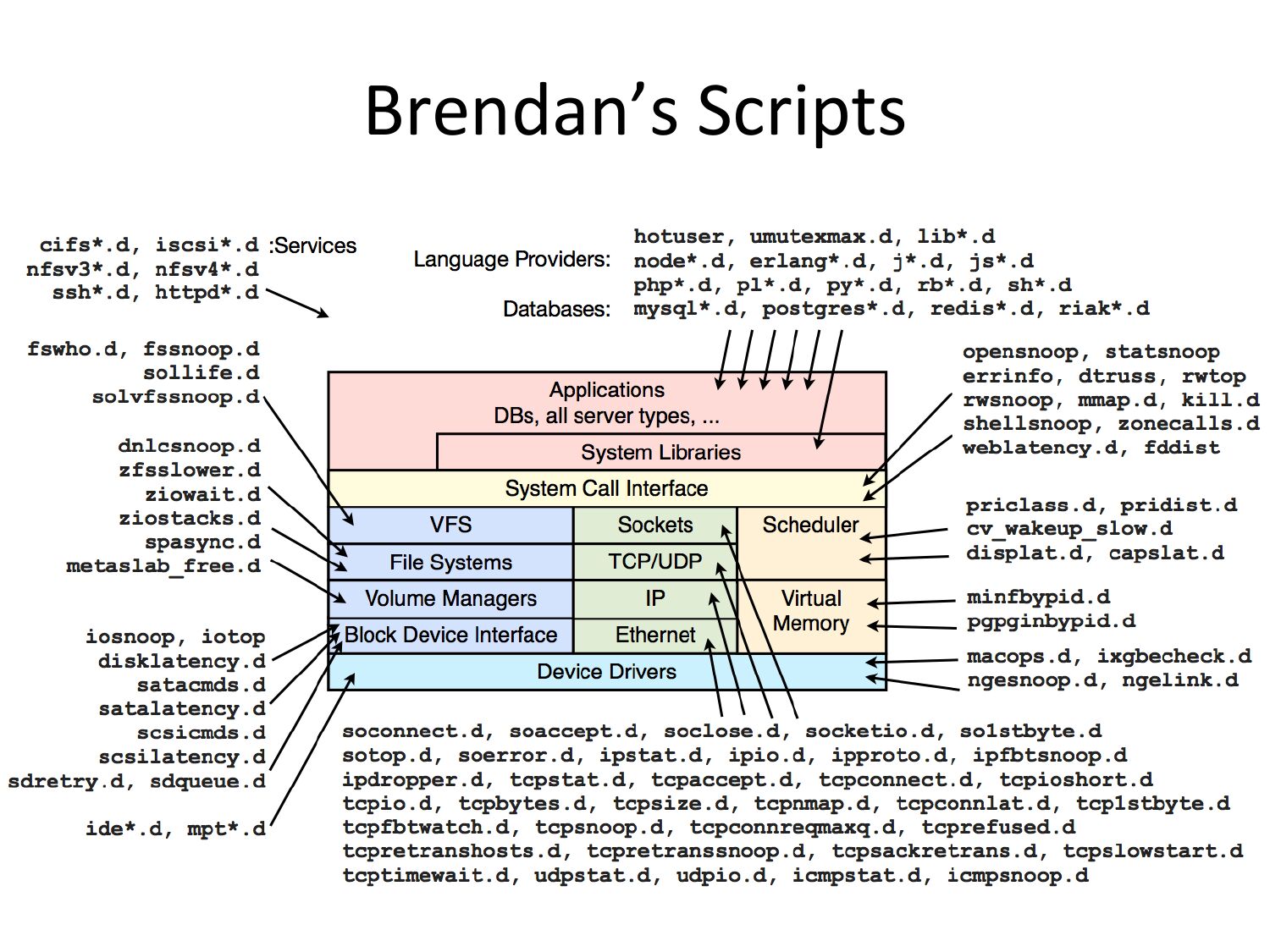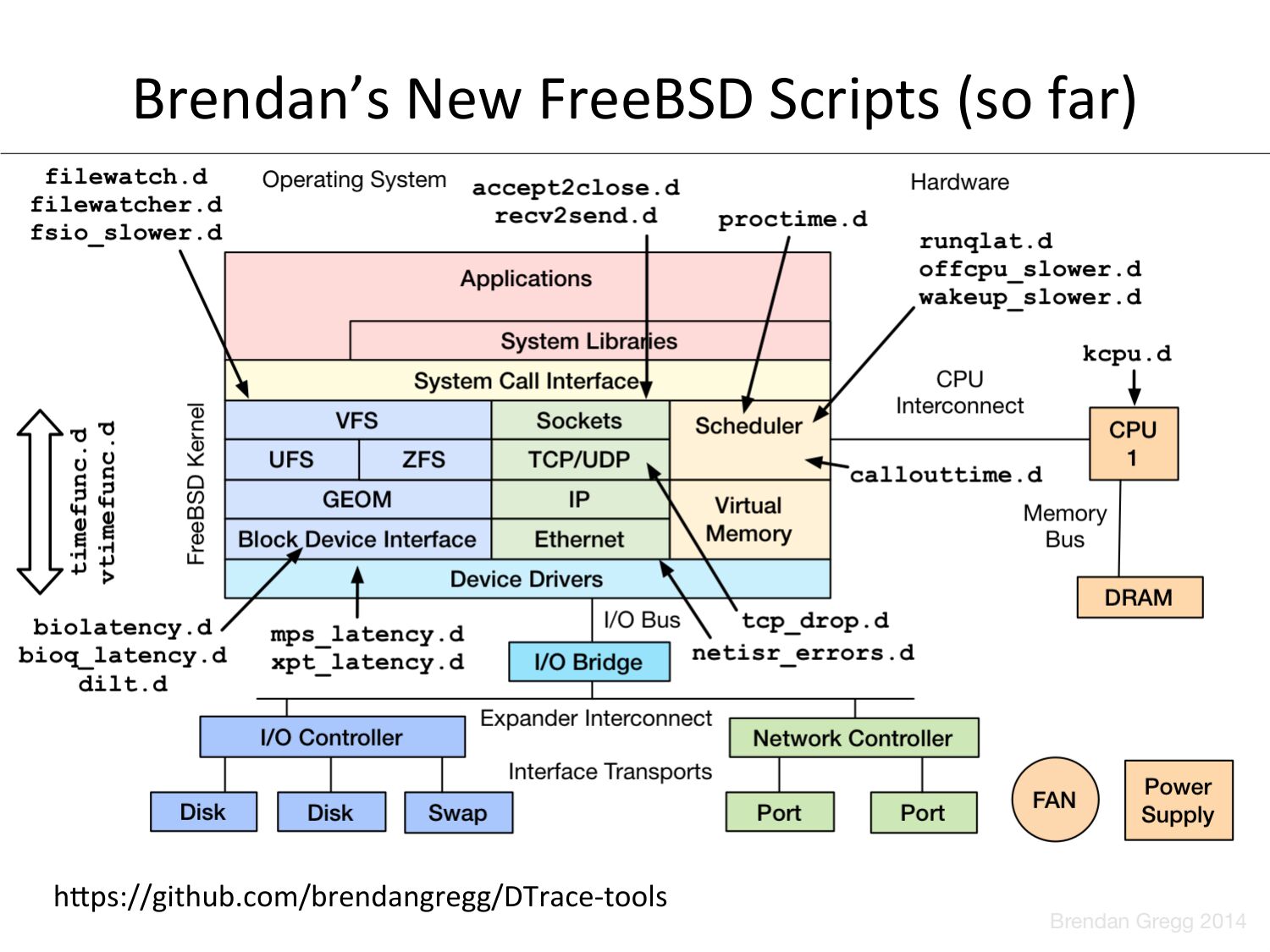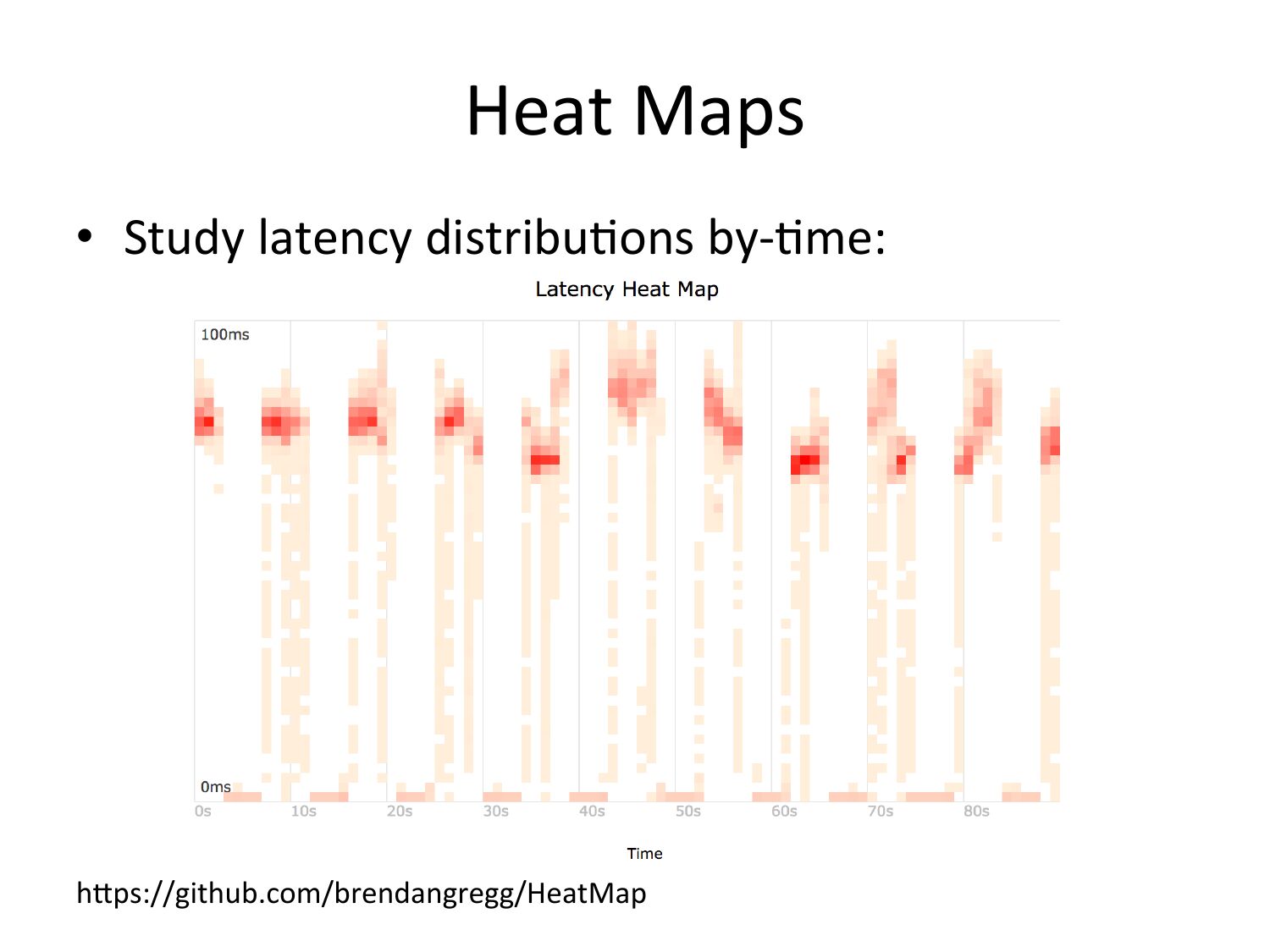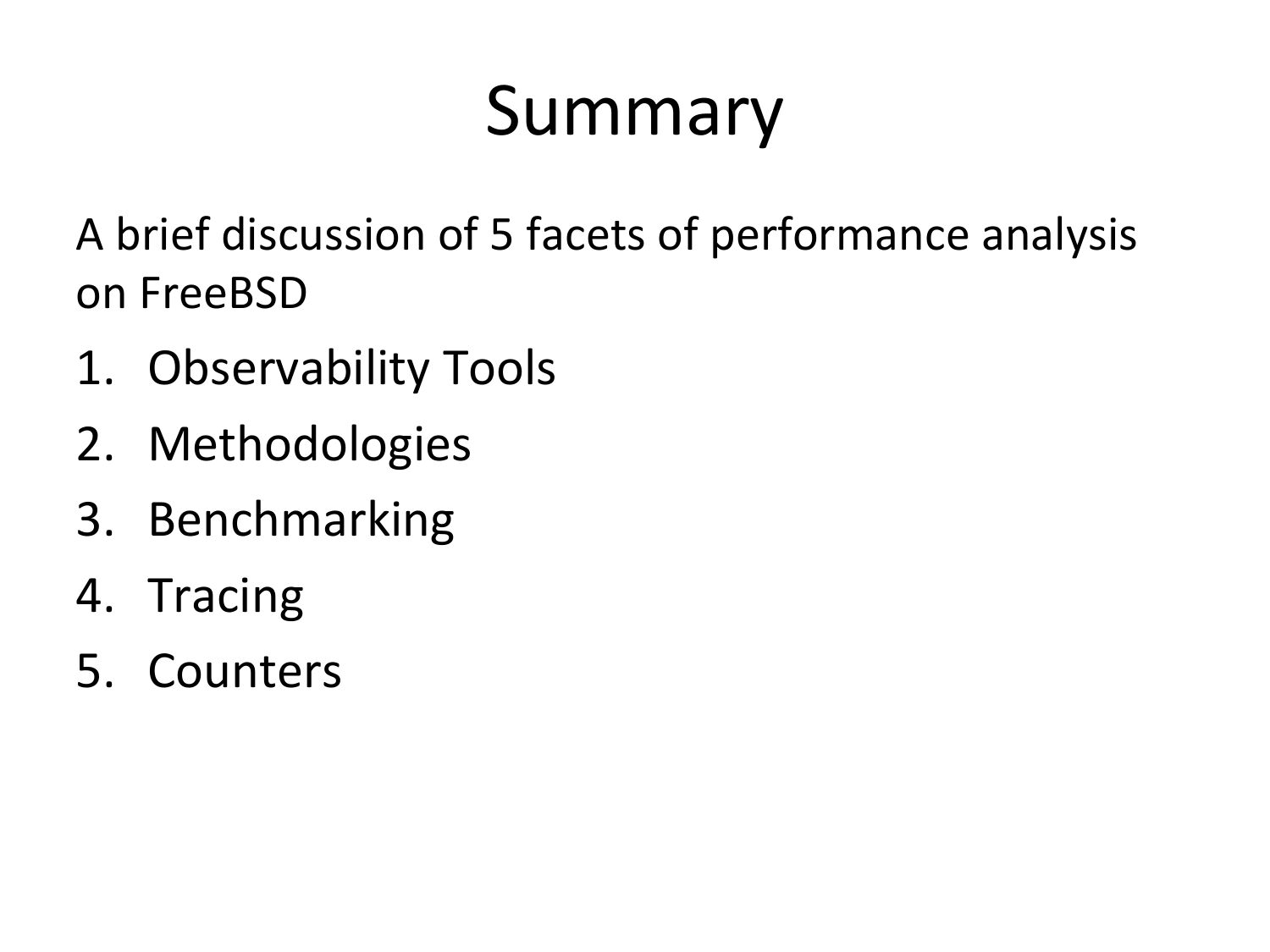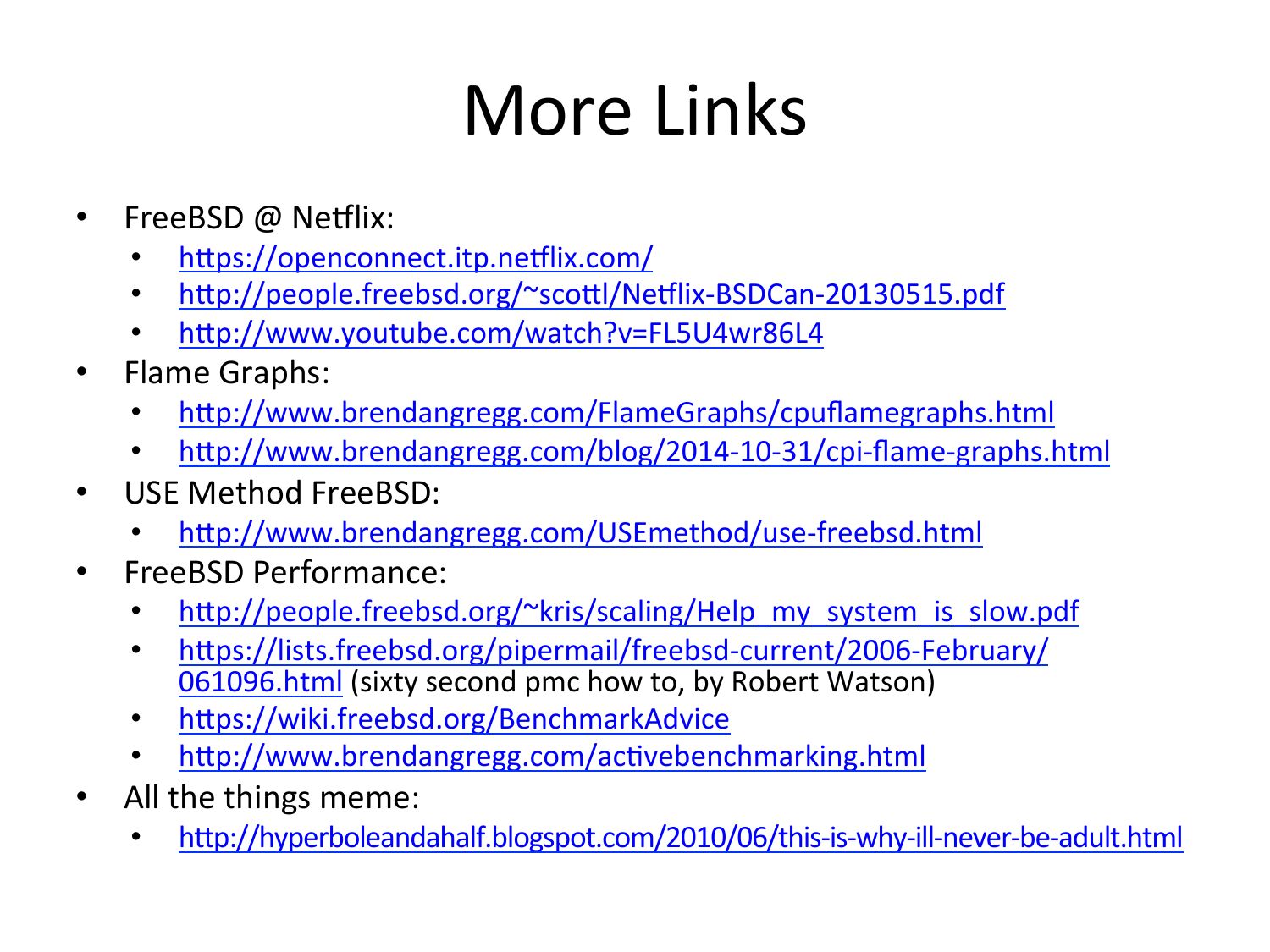MeetBSD 2014: Performance Analysis
Video: https://www.youtube.com/watch?v=uvKMptfXtdoMeetBSDCA 2014 Performance Analysis for BSD, by Brendan Gregg, Netflix.
Description: "A tour of five relevant topics: observability tools, methodologies, benchmarking, profiling, and tracing. Tools summarized include pmcstat and DTrace."
| next prev 1/60 | |
| next prev 2/60 | |
| next prev 3/60 | |
| next prev 4/60 | |
| next prev 5/60 | |
| next prev 6/60 | |
| next prev 7/60 | |
| next prev 8/60 | |
| next prev 9/60 | |
| next prev 10/60 | |
| next prev 11/60 | |
| next prev 12/60 | |
| next prev 13/60 | |
| next prev 14/60 | |
| next prev 15/60 | |
| next prev 16/60 | |
| next prev 17/60 | |
| next prev 18/60 | |
| next prev 19/60 | |
| next prev 20/60 | |
| next prev 21/60 | |
| next prev 22/60 | |
| next prev 23/60 | |
| next prev 24/60 | |
| next prev 25/60 | |
| next prev 26/60 | |
| next prev 27/60 | |
| next prev 28/60 | |
| next prev 29/60 | |
| next prev 30/60 | |
| next prev 31/60 | |
| next prev 32/60 | |
| next prev 33/60 | |
| next prev 34/60 | |
| next prev 35/60 | |
| next prev 36/60 | |
| next prev 37/60 | |
| next prev 38/60 | |
| next prev 39/60 | |
| next prev 40/60 | |
| next prev 41/60 | |
| next prev 42/60 | |
| next prev 43/60 | |
| next prev 44/60 | |
| next prev 45/60 | |
| next prev 46/60 | |
| next prev 47/60 | |
| next prev 48/60 | |
| next prev 49/60 | |
| next prev 50/60 | |
| next prev 51/60 | |
| next prev 52/60 | |
| next prev 53/60 | |
| next prev 54/60 | |
| next prev 55/60 | |
| next prev 56/60 | |
| next prev 57/60 | |
| next prev 58/60 | |
| next prev 59/60 | |
| next prev 60/60 |
PDF: MeetBSD2014_Performance.pdf
Keywords (from pdftotext):
slide 1:
Nov, 2014 Performance Analysis Brendan Gregg Senior Performance Architectslide 2:
BSD Observabilityslide 3:
• FreeBSD for content delivery – Open Connect Appliances – Approx 33% of US Internet traffic at night • AWS EC2 Linux cloud for interfaces – Tens of thousands of instances – CentOS and Ubuntu • Performance is criOcal – Customer saOsfacOon: >gt;50M subscribers – $$$ price/performanceslide 4:
Brendan Gregg • Senior Performance Architect, NeVlix – Linux and FreeBSD performance – Performance Engineering team (@coburnw) • Recent work: – New Flame Graph types with pmcstat – DTrace tools for FreeBSD OCAs • Previous work includes: – Solaris performance, DTrace, ZFS, methodologies, visualizaOons, findbillslide 5:
Agenda A brief discussion of 5 facets of performance analysis on FreeBSD 1. Observability Tools 2. Methodologies 3. Benchmarking 4. Tracing 5. Countersslide 6:
1. Observability Toolsslide 7:
How do you measure these?slide 8:
FreeBSD Observability Toolsslide 9:
Observability Tools • Observability tools are generally safe to use – Depends on their resource overhead • The BSDs have awesome observability tools – DTrace, pmcstat, systat • Apart from uOlity, an OS compeOOve advantage – Solve more perf issues instead of wearing losses • Some examples…slide 10:
upOme • One way to print load averages: • $ uptime! 7:07PM up 18 days, 11:07, 1 user, load averages: 0.15, 0.26, 0.25! • CPU demand: runnable + running threads – Not confusing (like Linux and nr_uninterrupOble) • ExponenOally-‐damped moving averages with Ome constants of 1, 5, and 15 minutes – Historic trend without the line graph • Load >gt; # of CPUs, may mean CPU saturaOon – Don’t spend more than 5 seconds studying theseslide 11:
top • Includes -‐P to show processors: # last pid: 32561; load averages: 2.67, 3.20, 3.03 up 6+17:13:49 19:20:59! 70 processes: 1 running, 69 sleeping! CPU 0: 0.8% user, 0.0% nice, 4.7% system, 19.5% interrupt, 75.0% idle! CPU 1: 2.3% user, 0.0% nice, 2.3% system, 17.2% interrupt, 78.1% idle! CPU 2: 2.3% user, 0.0% nice, 6.3% system, 21.1% interrupt, 70.3% idle! CPU 3: 0.8% user, 0.0% nice, 9.4% system, 14.1% interrupt, 75.8% idle! CPU 4: 0.8% user, 0.0% nice, 8.6% system, 12.5% interrupt, 78.1% idle! CPU 5: 1.6% user, 0.0% nice, 3.9% system, 15.6% interrupt, 78.9% idle! […]! Mem: 295M Active, 236G Inact, 9784M Wired, 1656M Buf, 3704M Free! Swap: 32G Total, 108M Used, 32G Free! PID USERNAME THR PRI NICE SIZE RES STATE TIME WCPU COMMAND! 1941 www -4 55512K 26312K kqread 9 512:43 4.98% nginx! 1930 www -4 55512K 24000K kqread 3 511:34 4.44% nginx! 1937 www -4 51416K 22648K kqread 4 510:32 4.35% nginx! 1937 www -4 51416K 22648K kqread 10 510:32 4.10% nginx! […]! • WCPU: weighted CPU, another decaying averageslide 12:
vmstat • Virtual memory staOsOcs and more: $ vmstat 1! procs memory page disks faults cpu! r b w avm fre flt re pi po fr sr md0 md1 cs us sy id! 3 11 0 2444M 4025M 1106 0 1980 0 3188 899 0 294 5140 2198 2 25 73! 0 11 0 2444M 3955M 0 2324 0 299543 105 0 75812 53510 397345 2 25 73! 1 11 0 2444M 3836M 0 2373 0 295671 105 0 76689 53980 411422 2 24 74! 0 11 0 2444M 3749M 19508 0 2382 0 308611 105 0 76586 56501 430339 3 26 71! 0 11 0 2444M 3702M 0 2373 0 303591 105 0 75732 55629 403774 2 23 75! […]! • USAGE: vmstat [interval [count]] • First output line shows summary since boot • High level system summary – scheduler run queue, memory, syscalls, CPU statesslide 13:
iostat • Storage device I/O staOsOcs: # iostat –xz 1! […]! device ada4 da1 da8 da18 da19 da25 da31 r/s workload analysis w/s resulOng performance extended device statistics ! kr/s kw/s qlen svc_t %b ! 2 ! 3 ! 1 ! 2 ! 1 ! 1 ! 2 ! • First output is summary since boot • Excellent metric selecOon • Wish it had -‐e for an error columnslide 14:
systat -‐ifstat • Network interface throughput: # systat –ifstat! /10! Load Average |||||||||||||||||| ! Interface Traffic Peak lo0 in 0.000 KB/s 16.269 KB/s out 0.000 KB/s 16.269 KB/s cxl0 in 31.632 MB/s 31.632 MB/s out 800.456 MB/s 800.456 MB/s • systat is a mulO-‐tool with other modes: – -‐tcp: TCP staOsOcs – -‐iostat: storage I/O, with histogram Total! 2.314 GB! 2.314 GB! 19.346 TB! 786.230 TB!slide 15:
systat -‐vmstat # systat -vmstat! 1 users Load 2.86 2.99 3.03 Mem:KB REAL VIRTUAL Tot Share Tot Share Free Act 358036 9040 2443624 12360 2723532 All 2408200 9576 3548292 Proc: Csw Trp Sys Int Sof 10 65 400k 24k 56k 74k 3503 Oct 30 19:57! VN PAGER SWAP PAGER! out out! count 2246! pages 306k! Interrupts! Flt ioflt 88456 total! 29 cow uart2 10! 92 zfod 1 ehci0 16! 5.7%Sys 18.8%Intr 2.1%User 0.0%Nice 73.4%Idle ozfod 2 ehci1 23! %ozfod 1129 cpu0:timer! ===+++++++++>gt; daefr 1 igb0:que 0! 25 dtbuf 5 prcfr 1 igb0:que 1! Namei Name-cache Dir-cache 2621440 desvn 285817 totfr 1 igb0:que 2! Calls hits hits 70104 numvn react 1 igb0:que 3! 182004 182004 100 40558 frevn pdwak 1 igb0:que 4! 104 pdpgs 1 igb0:que 5! Disks md0 md1 md2 md3 ada0 ada1 ada2 intrn 1 igb0:que 6! KB/t 0.00 0.00 0.00 0.00 520 10409576 wire 1 igb0:que 7! tps 251280 act igb0:link! MB/s 0.00 0.00 0.00 0.00 72.14 95.77 80.11 248112k inact t5nex0:evt! %busy cache 5720 t5nex0:0.0! 2727140 free 5652 t5nex0:0.1! 1696608 buf 5648 t5nex0:0.2! […]!slide 16:
DTrace # kldload dtrace! # dtrace -ln 'fbt:::entry' ! PROVIDER MODULE fbt kernel fbt kernel fbt kernel fbt kernel fbt kernel fbt kernel fbt kernel fbt kernel fbt kernel fbt kernel fbt kernel fbt kernel fbt kernel fbt kernel fbt kernel fbt kernel fbt kernel fbt kernel fbt kernel fbt kernel fbt kernel fbt kernel […28472 lines truncated…]! FUNCTION NAME! camstatusentrycomp entry! cam_compat_handle_0x17 entry! cam_periph_done entry! camperiphdone entry! heap_down entry! cam_ccbq_remove_ccb entry! cam_module_event_handler entry! camisr_runqueue entry! xpt_alloc_device_default entry! xpt_async_process entry! xpt_async_process_dev entry! xpt_async_process_tgt entry! xpt_boot_delay entry! xpt_config entry! xpt_destroy_device entry! xpt_dev_async_default entry! xpt_done_process entry! xpt_done_td entry! xpt_finishconfig_task entry! xpt_modevent entry! xpt_periph_init entry! xpt_release_bus entry!slide 17:
run all the things?slide 18:
2. Methodologiesslide 19:
Methodologies & Tools • Many awesome tools – Only awesome if you actually use them – The real problem becomes how to use them • Methodologies can guide usageslide 20:
An5-‐Methodologies • The lack of a deliberate methodology… • Street Light AnO-‐Method: – 1. Pick observability tools that are • Familiar • Found on the Internet • Found at random – 2. Run tools – 3. Look for obvious issues • Drunk Man AnO-‐Method: – Tune things at random unOl the problem goes awayslide 21:
Methodologies • For example, the USE Method: – For every resource, check: • UOlizaOon • SaturaOon • Errors X Resource UOlizaOon (%) • 5 Whys: Ask “why?” 5 Omes • Other methods include: – Workload characterizaOon, drill-‐down analysis, event tracing, baseline stats, staOc performance tuning, … • Start with the quesOons, then find the toolsslide 22:
USE Method for Hardware • For every resource, check: – UOlizaOon – SaturaOon – Errors • Including busses & interconnectsslide 23:
(hpp://www.brendangregg.com/USEmethod/use-‐freebsd.html)slide 24:
3. Benchmarkingslide 25:
~100% of benchmarks are wrongslide 26:
The energy needed to refute benchmarks is mulOple orders of magnitude bigger than to run themslide 27:
Benchmarking • Apart from observaOonal analysis, benchmarking is a useful form of experimental analysis – Try observaOonal first; benchmarks can perturb • However, benchmarking is error prone: – TesOng the wrong target: eg, FS cache instead of disk – Choosing the wrong target: eg, disk instead of FS cache … doesn’t resemble real world usage – Invalid results: eg, bugs – Misleading results: you benchmark A, but actually measure B, and conclude you measured C • FreeBSD has ministat for staOsOcal analysisslide 28:
Benchmark Examples • Micro benchmarks: – File system maximum cached read operaOons/sec – Network maximum throughput • Macro (applicaOon) benchmarks: – Simulated applicaOon maximum request rate • Bad benchmarks: – gitpid() in a Oght loop – Context switch Omingslide 29:
The Benchmark Paradox • Benchmarking is used for product evaluaOons – Eg, evaluaOng a switch to BSD • The Benchmark Paradox: – If your product’s chances of winning a benchmark are 50/50, you’ll usually lose – hpp://www.brendangregg.com/blog/2014-‐05-‐03/the-‐benchmark-‐ paradox.html • Solving this seeming paradox (and benchmarking in general)…slide 30:
For any given benchmark result, ask: why isn’t it 10x?slide 31:
AcOve Benchmarking • Root cause performance analysis while the benchmark is sOll running – Use the observability tools menOoned earlier – IdenOfy the limiter (or suspected limiter) and include it with the benchmark results – Answer: why not 10x? • This takes Ome, but uncovers most mistakesslide 32:
4. Profilingslide 33:
Profiling • Can you do this? “As an experiment to investigate the performance of the resulting TCP/IP implementation ... the 11/750 is CPU saturated, but the 11/780 has about 30% idle time. The time spent in the system processing the data is spread out among handling for the Ethernet (20%), IP packet processing (10%), TCP processing (30%), checksumming (25%), and user system call handling (15%), with no single part of the handling dominating the time in the system.”slide 34:
Profiling • Can you do this? “As an experiment to investigate the performance of the resulting TCP/IP implementation ... the 11/750 is CPU saturated, but the 11/780 has about 30% idle time. The time spent in the system processing the data is spread out among handling for the Ethernet (20%), IP packet processing (10%), TCP processing (30%), checksumming (25%), and user system call handling (15%), with no single part of the handling dominating the time in the system.” – Bill Joy, 1981, TCP-‐IP Digest, Vol 1 #6 hpps://www.rfc-‐editor.org/rfc/museum/tcp-‐ip-‐digest/tcp-‐ip-‐digest.v1n6.1slide 35:
Profiling Tools • pmcstat • DTrace • ApplicaOon specific productsslide 36:
pmcstat • pmcstat counts PMC events, or records samples of kernel or user stacks – Eg, kernel stack every 64k L2 misses • Performance monitoring counter (PMC) events – Low level CPU behavior: cycles, stalls, instrucOons, cache hits/misses • FreeBSD has great PMC docs • eg, PMC.SANDYBRIDGE(3), PMC.IVYBRIDGE(3), …slide 37:
pmcstat Profiling • Sampling stall cycles: # pmcstat –S RESOURCE_STALLS.ANY -O out.pmc sleep 10! # pmcstat -R out.pmc -z 32 -G out.stacks! CONVERSION STATISTICS:! #exec/elf 25! #samples/total 107362! #samples/unknown-function 244! #callchain/dubious-frames 89! # more out.stacks! @ RESOURCE_STALLS.ANY [16561 samples]! 18.25% [3023] copyout @ /boot/kernel/kernel! 99.93% [3021] soreceive_generic! 100.0% [3021] kern_recvit! 100.0% [3021] sys_recvfrom! 100.0% [3021] amd64_syscall! 00.07% [2] amd64_syscall! Can also emit 13.28% [2200] copyin @ /boot/kernel/kernel! gprof/Kcallgrind 100.0% [2200] ffs_write! 100.0% [2200] VOP_WRITE_APV! output […]!slide 38:
PMC Counters • Profile based on any counter: # pmccontrol -L! […]! branch-instruction-retired! branch-misses-retired! instruction-retired! llc-misses! llc-reference! unhalted-reference-cycles! unhalted-core-cycles! LD_BLOCKS.DATA_UNKNOWN! LD_BLOCKS.STORE_FORWARD! LD_BLOCKS.NO_SR! LD_BLOCKS.ALL_BLOCK! MISALIGN_MEM_REF.LOADS! MISALIGN_MEM_REF.STORES! LD_BLOCKS_PARTIAL.ADDRESS_ALIAS! LD_BLOCKS_PARTIAL.ALL_STA_BLOCK! DTLB_LOAD_MISSES.MISS_CAUSES_A_WALK! DTLB_LOAD_MISSES.WALK_COMPLETED! DTLB_LOAD_MISSES.WALK_DURATION! […]! Beware of high frequency events, and use -‐n to limit samplesslide 39:
PMC Counter Groups • Counters by group (eg, Intel Sandy Bridge): # pmccontrol -L | sed -n '/[_\.-]/s/[_\.-].*//p' | sort | \! uniq –c | sort -n | pr -t3! 1 !AGU! 2 !LOAD ! 4 !CPU! 1 !ARITH ! 2 !LONGEST! 4 !OTHER! 1 !BACLEARS ! 2 !MISALIGN ! 5 !ITLB! 1 !HW ! 2 !OFF! 6 !L1D! 1 !ICACHE ! 2 !SIMD ! 6 !LD! 1 !INSTR ! 2 !TLB! 7 !IDQ! 1 !INSTS ! 2 !branch ! 7 !OFFCORE! 1 !ROB! 2 !llc! 8 !DTLB! 1 !RS ! 2 !unhalted ! 10 !FP! 1 !SQ ! 3 !CLOCK ! ! 12 !RESOURCE! 1 !instruction! 3 !CYCLE ! ! 15 !UOPS! 2 !CPL! 3 !DSB! ! 22 !MEM! 2 !DSB2MITE ! 3 !LOCK ! ! 31 !BR! 2 !ILD! 3 !MACHINE! ! 37 !L2! 2 !INST ! 3 !PAGE! 2 !INT! 3 !PARTIAL!slide 40:
How do you measure these?slide 41:
PMC groups eg, Intel Sandy Bridgeslide 42:
DTrace
Profiling
• Kernel
stack
sampling
at
199
Hertz,
60
s:
# kldload dtraceall
# if needed!
# dtrace -x stackframes=100 -n 'profile-199 /arg0/ {!
@[stack()] = count(); } tick-60s { exit(0); }' -o out.stacks!
• User
stack
sampling
at
99
Hertz,
60
s:
# dtrace -x ustackframes=100 -n 'profile-99 /arg1/ {!
@[ustack()] = count(); } tick-60s { exit(0); }' -o out.stacks!
• Warnings:
– ustack()
can
be
expensive
– Short-‐lived
processes
will
miss
symbol
translaOon
slide 43:DEMOslide 44:
Flame
Graphs
• CPU
flame
graph
(using
DTrace):
git clone https://github.com/brendangregg/FlameGraph!
## cd
FlameGraph!
# kldload dtraceall
# if needed!
# dtrace -x stackframes=100 -n 'profile-197 /arg0/ {!
@[stack()] = count(); } tick-60s { exit(0); }' -o out.stacks!
# ./stackcollapse.pl out.stacks | ./flamegraph.pl >gt; out.svg!
• Stall
cycle
flame
graph
(using
pmcstat):
… !
# pmcstat –S RESOURCE_STALLS.ANY -O out.pmcstat sleep 10!
# pmcstat -R out.pmcstat -z100 -G out.stacks!
# ./stackcollapse-pmc.pl out.stacks | ./flamegraph.pl >gt; out.svg!
slide 45:cpu-‐freebsd02.svgslide 46:
cpi-‐flamegraph-‐01.svgslide 47:
5. Tracingslide 48:
Tracing Tools • truss • tcpdump • ktrace • DTraceslide 49:
DTrace • Kernel and user-‐level tracing, programmaOc • Instruments probes provided by providers • Stable interface providers: – io, ip, lockstat, proc, sched, tcp, udp, vfs • Unstable interface providers: – pid: user-‐level dynamic tracing – zt: (funcOon boundary tracing) kernel dynamic tracing – syscall: system calls (maybe unstable) • Providers should be developed/enhanced on BSDslide 50:
Learning DTrace on FreeBSD • hpps://wiki.freebsd.org/DTrace • hpps://wiki.freebsd.org/DTrace/Tutorial • hpps://wiki.freebsd.org/DTrace/One-‐Liners • There’s also a good reference on how the kernel works, for when using kernel dynamic tracing:slide 51:
Using DTrace • PracOcal usage for most companies: – A) A performance team (or person) • Acquires useful one-‐liners & scripts • Develops custom one-‐liners & scripts – B) The rest of the company asks (A) for help • They need to know what’s possible, to know to ask – Or, you buy/develop a GUI that everyone can use • There are some excepOons – Team of kernel/driver developers, who will all write custom scriptsslide 52:
DTrace
One-‐liners
# Trace file opens with process and filename:!
dtrace -n 'syscall::open*:entry { printf("%s %s", execname, copyinstr(arg0)); }'!
# Count system calls by program name:!
dtrace -n 'syscall:::entry { @[execname] = count(); }'!
# Count system calls by syscall:!
dtrace -n 'syscall:::entry { @[probefunc] = count(); }'!
# Count system calls by syscall, for PID 123 only:!
dtrace -n 'syscall:::entry /pid == 123/ { @[probefunc] = count(); }'!
# Count system calls by syscall, for all processes with a specific program name ("nginx"):!
dtrace -n 'syscall:::entry /execname == "nginx"/ { @[probefunc] = count(); }'!
# Count system calls by PID and program name:!
dtrace -n 'syscall:::entry { @[pid, execname] = count(); }'!
# Summarize requested read() sizes by program name, as power-of-2 distributions (bytes):!
dtrace -n 'syscall::read:entry { @[execname] = quantize(arg2); }'!
# Summarize returned read() sizes by program name, as power-of-2 distributions (bytes or error):!
dtrace -n 'syscall::read:return { @[execname] = quantize(arg1); }'!
# Summarize read() latency as a power-of-2 distribution by program name (ns):!
dtrace -n 'syscall::read:entry { self->gt;ts = timestamp; } syscall::read:return /self->gt;ts/ {!
@[execname, "ns"] = quantize(timestamp - self->gt;ts); self->gt;ts = 0; }’!
[…]!
For
more,
see
hpps://wiki.freebsd.org/DTrace/One-‐Liners
slide 53:Brendan’s Scripts DTraceToolkitslide 54:
Brendan’s Scriptsslide 55:
Brendan’s New FreeBSD Scripts (so far) hpps://github.com/brendangregg/DTrace-‐toolsslide 56:
DEMOslide 57:
Heat Maps • Study latency distribuOons by-‐Ome: hpps://github.com/brendangregg/HeatMapslide 58:
Summary A brief discussion of 5 facets of performance analysis on FreeBSD 1. Observability Tools 2. Methodologies 3. Benchmarking 4. Tracing 5. Countersslide 59:
More Links FreeBSD @ NeVlix: Flame Graphs: hpp://www.brendangregg.com/USEmethod/use-‐freebsd.html FreeBSD Performance: hpp://www.brendangregg.com/FlameGraphs/cpuflamegraphs.html hpp://www.brendangregg.com/blog/2014-‐10-‐31/cpi-‐flame-‐graphs.html USE Method FreeBSD: hpps://openconnect.itp.neVlix.com/ hpp://people.freebsd.org/~scopl/NeVlix-‐BSDCan-‐20130515.pdf hpp://www.youtube.com/watch?v=FL5U4wr86L4 hpp://people.freebsd.org/~kris/scaling/Help_my_system_is_slow.pdf hpps://lists.freebsd.org/pipermail/freebsd-‐current/2006-‐February/ 061096.html (sixty second pmc how to, by Robert Watson) hpps://wiki.freebsd.org/BenchmarkAdvice hpp://www.brendangregg.com/acOvebenchmarking.html All the things meme: hpp://hyperboleandahalf.blogspot.com/2010/06/this-‐is-‐why-‐ill-‐never-‐be-‐adult.htmlslide 60:
Thanks • QuesOons? • hpp://slideshare.net/brendangregg • hpp://www.brendangregg.com • bgregg@neVlix.com • @brendangregg



